





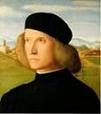

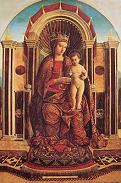

1490 On Feb. 12 Marquis Francesco II Gonzaga of Mantua marries brainy glam babe Isabella d'Este (1474-1539), "First Lady of the Renaissance", who governs during his many military absences, and turns Mantua into a cultural showplace with artists Raphael and Andrea Mantegna (1431-1506), composers Bartolomeo Troncino and Marchetto Cara, and sculptor Pier Jacopo Alari Bonacolsi (AKA L'Antico), building the Palace of St. Sebastian, complete with Mantegna's Triumph of Caesar, and getting her portrait done by Leonardo da Vinci and Titian (twice); next year she instructs her agent to get her a black girl age 4-8, "shapely and as black as possible", adding "We shall make her very happy and shall have great fun with her". On Mar. 13 Charles I the Warrior (b. 1468) dies, and his infant son Cahrles John Amadeus becomes Duke Charles II (1489-96) of Savoy, Jerusalem, Cyprus and Armenia (until 1496), with his mother Blanche of Montferrat (1472-1519) as regent. On Apr. 6 after capturing and occupying Vienna, king Matthias Corvinus (b. 1443) of Hungary and Bohemia dies, and Bohemian king (since 1471) Ladislav (Vladislas) (Uladislaus) II Jagiello (1456-1516) of Bohemia, son of Casimir IV of Poland and Anne of Bohemia becomes king of Hungary, moving the royal residence to Ofen (Budapest). On Dec. 19 Maximilian I of Austria marries 13-y.-o. heiress Anne of Brittany (1477-1514) (daughter of Duke Francis I of Brittany) by proxy, giving her the title of queen of the Romans, pissing-off Charles VIII since he is supposed to give his approval first via the Treaty of Verger, plus it gives Brittany to an enemy of France. Frederick III resigns most of his duties as HRE to his son Maximilian I of Austria, who acquires the Tirol from Archduke Sigismund of Austria after the pop. turns against him; Frederick III names Linz as the capital of the province of Upper Austria. Charles VIII of France repudiates the Treaty of Arras along with his betrothal to 10-y.-o. Margaret of Austria, daughter of Maximilian I. Abdul Mu'min (Mumin) is overthrown by Abu Zikirya Yahya in Tunisia. Portuguese missionaries and artisans go to the Congo, where they convert King Mani-Kongo. Civil war begins in Monomotapa (Monomutapa) (AKA Mokaranga) in E Africa (modern-day Zimbabwe), stretching from the Zambesi River to the mouth of the Fish River; in early 1561 Jesuit priest Goncalo da Silveira Christianizes the king and many of his people, but some Muslim refugees from Mozambique cause kingy to flop and strangle him on Mar. 16. The Shilluk Kingdom (ends 1865) on the banks of the White Nile River in modern-day S Soudan is founded as a sacred monarchy by Nyikango, in which the king (reth) is also the chief priest, worshipping Juok; the kingdom reaches its zenith under king Dhokoth in 1670-90, after which King Tugo establishes Fashoda (modern-day Kodok or Kothok) as the capital, living on a homestead mound in four huts. The fortified island of Saint-Malo in NW Brittany at the mouth of the Rance River declares itself an independent repub., with the motto "Not French, not Breton, but Malouins"; explorer Jacques Cartier is born there in 1491. Out of Rome's pop. of 100K, about 6.8K are "respectable courtesans" (legal prostitutes) catering to the pilgrim and tourist trade. Ferdinand II of Castile and Aragon sends Pope Innocent VII a gift of 100 Moorish slaves, which he shares with cardinals and close friends. Yoshimasa disinherits his brother, and makes his son Yoshitane shogun. A revolt in Bidar, India against incompetent ruler Mahmud causes the secession of Berar (until 1574), Ahmadnagar (until 1633) and Bijapur (until 1686). Royal confessor John Ireland presents Scottish king James IV with The Meroure of Wyssdome, his manual of kingship. Permanent ambassadors come into existence in Europe during this decade. A wave of meteorites impacts Qingyang, Shangxi China with such ferocity that stones fall like rain, killing tens of thousands? In this decade the fierce cannibal Caribe (Canibal) (Caníbal) (Sp. for cannibal) tribe, originally from the Orinoco River Valley expels the Arawaks from the coast of Venezuela, and spreads to the Lesser and Greater Antilles, Bahamas, and the Atlantic coastline from Fla. to S Brazil; their canoes make use of sails, and they run fleets of as many as 100 at a time. The first orphanages open in Italy and Holland. Spanish drama begins its unique development. Ballet is born in the courts of Italy. Where is the love? In this decade the profession of book publisher (type founder, printer, bookseller) emerges just in time to receive mss. from explorers telling about nude women running around in exotic lands?; Greek and Latin scholar Aldus Manutius (1449-1515) and his family found the Aldine Press in Venice (later Rome) to pub. Greek and Latin classics in small low-cost "pocket book" format with financial help from Prince Alberto Pio of Carpi (until 1597), starting with a 5-vol. folio Aristotle (1494-98), and later Euripides, Plato, and Plutarch, using noted classical scholars in their production and becoming the first printer to use small capitals and italics in an Italian ed. of Vergil (1501), turning Venice into the printing capital of Europe, issuing 130 works (incl. 30 in Greek) by 1515; the Aldine Logois an anchor and dolphin. Sports: En passant is introduced in chess. Architecture: About this time Manuel I of Portugal founds Manueline Architecture (ends 1520) to show off his newfound wealth from the voyages of Vasco da Gama and Pedro Alvares Cabral and the resulting spice trade with India and Africa, combining flamboyant Late Gothic with Italian, Flemish, Plateresque, and Mudejar architecture. In this decade Knole House in Sevenoaks, W Kent (SE of London), England is built, becoming one of England's largest houses, helping the village grow. Science: Italian brain man Leonardo da Vinci (1452-1519) describes Capillary Action after Veronese anatomist Marc Antonia Della Torre dies and he dissects 10 human bodies in the cellar of the Santa Spirito by candlelight to fulfill a vow to him. In this decade Saccharomyces eubayanus yeast is brought back from the beech trees in Patagonia in South Am., making it possible for Bavarians to brew the first clear cold-fermented lager beer after fusing it with their yeast. Art: Gentile Bellini (1427-1507), Madonna and Child Enthroned; shows an Islamic prayer rug at the Virgin Mary's feet. Giovanni Bellini (1430-1516), Portrait of a Young Man in Black. Vittore Carpaccio (1460-1526), Life of St. Ursula (9 scenes) (1490-); incl. Dismissal of the Ambassadors, The Departure of the Betrothed Pair, St. Ursula's Dream; best Venice pageant series of the cent.? Albrecht Durer (1471-1528), Portrait of Artist's Father; makes another one in 1497. Domenico Ghirlandaio (1449-94), The Birth of Mary. Quentin Massys, St. Christopher (sometime in this decade?) Plays: The first Corpus Christi Play is performed in Eger, Bohemia. Poetry: The anon. Scottish poem Lancelot of the Laik is written in this decade. Births: French traitor gen. (constable of France) Charles III de Montpensier and de Bourbon, Duke de Chatellerault, Viceroy of Languedoc and Milan (AKA Constable de Bourbon) (d. 1527) on Feb. 17 in Montpensier; son of Count Gilbert of Montpensier and Claire de Gonzaga; his sister is the wife of the duke of Lorraine, grandson of Iolande de Bar and great-grandson of Rene I of Anjou; marries the only daughter of the duke of Bourbon, uniting the only branches of the Bourbon family to retain the old feudal power, along with vast estates, making him the most powerful man in France at the start of the 16th cent. Italian duke of Urbino (1508-16) Francesco Maria I della Rovere (d. 1538) on Mar. 22 in Senigallia; son of Giovanni della Rovere and Giovanna da Montefeltro (daughter of Federico III da Montefeltro); nephew of Guiliano della Rovere (Pope Julius II) (1443-1513) and Guidobaldo I of Urbino (1472-1508); father of Guidobaldo II della Rovere (1514-74). Italian poet (member of the Spirituali) Vittoria Colonna (d. 1547) in Apr.; daughter of Fabrizio Colonna (1450-1520); friend of Michelangelo. Prussian duke #1 (1525-68) (elector-archbishop of Mainz in 1514-45) (archbishop of Magdeburg in 1513-45) (37th grandmaster of the Teutonic Knights in 1511-25) Albrecht (Albert) I of Hohenzollern (Brandenburg) (d. 1568) on May 16 in Ansbach, Franconia; 3rd son of Frederick I of Brandenburg-Ansbach and Sophia Jagiellon; maternal nephew of Sigismund I the Old of Lithuania-Poland. German duke of Cleves (1521-38) John III (the Peaceful) (d. 1538) on Nov. 10; son of John II the Babymaker of Cleves (1458-1521) and Matilda of Hesse; great-great-grandson of Duke John the Fearless of Burgundy; father of Anne of Cleves (1515-57). German Lutheran theologian Friedrich Myconius (Mykonius) (Mekum) (d. 1546) on Dec. 26 in Lichtenfels am Main; asst. of Martin Luther. Ottoman Sunni Hanafi legal scholar and grand mufti (sheik ul-islam) (1545-74) Mehmed Ebussuud Efendi (d. 1574) on Dec. 30 in Imadiyye. German Franconian Protestant rebel leader Florian Geyer (Geier) of Giebelstadt (d. 1525) in Giebelstadt, Lower Franconia. Italian Renaissance painter (in Rome) Maturino da Firenze (d. 1528) in Florence; collaborator of Polido da Caravaggio (1495-1543). German papal nuncio (Roman Catholic) Karl von Miltitz (d. 1529) in Rabenau (near Dresden). German Anabaptist reformer-rebel Michael Gaismair (d. 1532) in Sterzing, Tyrol. Jewish mystery man David Reubeni (Reuveni) (d. 1541) in Khaybar? Belgian (Flemish) painter and tapestry designer Bernard (Barend) van Orley (d. 1542) in Brussels. English composer-organist John Taverner (d. 1545). Spanish viceroy #1 of Peru (1544-6) Blasco Nunez (Nuñez) de Vela y Villalba (d. 1546) (b. 1490?) in Avila. Scottish poet Sir David Lindsay (d. 1555). Italian physician-botanist Luca Ghini (d. 1556) in Casalfiumanese; educated at the U. of Bologna. Spanish conquistador Alvar Nunez (Álvar Núñez) Cabeza de Vaca (Sp. "cow head") (d. 1557) (b. 1488?) (b. 1492?) in Jerez de la Frontera. English surgeon-physician-anatomist Thomas Vicary (d. 1561) in Kent. Dutch (Flemish) composer Adrian Willaert (d. 1562) in Bruges (Roulers); pupil of Jean Moulin (pupil of Josquin Depres). French composer Claudin de Sermisy (d. 1562). German archbishop, Teutonic Knights grandmaster (1511-25) and Prussian duke #1 (1525-68) Albert (Hohenzollern) of Brandenburg (d. 1568); father of Albert Frederick; father-in-law of John Sigismund. Deaths: Hungarian-Bohemian king Matthias Corvinus (b. 1443) on Apr. 6 in Vienna.




1491 In Jan. Ludovico Sforza "the Moor" of Milan marries glam babe Beatrice d'Este (1475-97) (sister of glam babe Isabella d'Este), and in the same ceremony her brother Alfonso I d'Este (1476-1534) (future duke of Ferrara) marries Anna Sforza (1476-97), sister of Gian Galeazzo Sforza; Leonardo da Vinci orchestrates the wedding celebration; Beatrice goes on to turn Milan into a showplace with poets and artists incl. Leonardo (who does her portrait as a wedding gift), Bramante, Bernardo Castiglione and Niccola da Gorreggio; too bad, she dies in childbirth at age 22 in 1497, while Anna dies the same year the same way at age 21. In Apr. Boabdil repudiates his agreement with the Castilians and refuses to pay tribute, and they siege Granada in the spring, destroying their own camp by an accidental fire then rebuilding it in stone in the form of a white cross called Santa Fe (Holy Faith) - his jig is aboabdil up? In May the First Ottoman-Mamluk War (begun 1485) ends with a peace treaty, leaving the pre-war status quo. In the summer Henry VII leads English forces to fight France (ends 1492). On Nov. 7 the Peace (Treaty) of Pressburg (Bratislava) is signed by HRE Maximilian I and Vladislaus II of Bohemia-Hungary in front of 63 dignitaries, ending the Austrian-Hungarian War of 1477-88; Vladislaus II renounces his claim to Lower Austria and acknowledges the Hapsburg right of succession if he leaves no male heir; too bad, he has a son in 1506, nullifying this condition. In Nov. Perkin Warbeck (1474-99) lands in Ireland, claiming to be Richard of Shrewsbury, Duke of York, 2nd son of Edward IV, younger brother of Edward V, and one of the Princes in the Tower, gaining supporters to overthrow Henry VII incl. Hugh Roe O'Donnell, king of Tyrconnell, while Henry VII declares him an imposter; in 1497 after making several unsuccessful landings in England with his small armies, he surrenders in Hampshire, and confesses to being a Fleming born in Tournai; his revolt costs Henry VII £13K, straining his financial resources. On Dec. 6 after sieging and capturing Rennes and capturing her while her hubby Maximilian I fails to show up, then forcing her to engage him in the Vault of the Jacobins, and having her travel escorted by her army to Langeais to prove she's not being coerced, Charles VIII of France marries Anne of Brittany (1477-1514) at Langeais Castle, uniting Brittany to the French crown, ignoring her marriage to Max Headroom I and his own betrothal to Max's daughter Margaret of Austria, then frees himself from the regency of his sister Anne of Beaujeu and takes control of French affairs (although she becomes regent again when he's out of France), turning his eyes to Naples; Anne is prohibited from using the title of duchess of Britanny, but the marriage contract provides that the spouse who outlives the other will retain it; it also states that if Charles dies without male heirs, Anne will marry her successor in order to allow the French kings a second chance to permanently annex Brittany; Pope Innocent VIII validates the marriage next Feb. 15, a week after she is crowned queen of France in Saint-Denis on Feb. 8; she brings two beds with her when moving in with the prick, and they usually sleep apart, but she goes on to have four children, all of whom die before age four. On Dec. 21 the 5-year Truce of Coldstream is signed between England and Scotland. Dresden, the capital of Saxony burns down - wait till 1945? Jivaraj Papdiwal installs thousands of Jainist idols in temples throughout India; incl. 100K Jain images; Buddhism is virtually extinguished in India. Alsatian-born Roman Catholic priest Johann (Johannes) Burchard (Burchart) (Burkhart) (1450-1506), the pope's master of ceremonies writes in his diary: "From the greatest to the least, they [the church's top officials] took on concubines in the fashion of marriage, and indeed they did this publicly... Unless God provides, this corruption will spread to monks and those in religious orders, although the convents of Rome have almost become all brothels even now, since no one forbids it." Copper and silver are discovered in Komi, causing Russia to annex it in ?. A paper mill is founded in Cracow. 18-y.-o. Nicolaus Copernicus (b. 1473) begins studying at Cracow U. Sports: James IV of Scotland signs a law prohibiting the playing of Golf (along with soccer and other worthless amusements taking Scots away from military preparations), then repeals it after trying it himself? Nonfiction: John Alcock (1430-1500), Hill of Perfection; Sermons upon the Eighth Chapter of Luke. Art: Domenico Ghirlandaio (1449-94), La Visitation Entre Marie Jacobie et Marie Salome. Martin Schongauer (1448-91), The Last Judgment (mural) (Breisach). Births: English king (1509-47) Henry VIII (d. 1547) on June 28 [Cancer] in Greenwich at Placentia Palace; 2nd son of Henry VII (1457-1509) and Elizabeth of York (1466-1503); his nurse is Anne Luke; husband of (1509-33) Catherine of Aragon (1485-1536), (1533-6) Anne Boleyn (1507-36), (1536-7) Jane Seymour (1508-37), (1540) Anne of Cleves (1515-57), (1540-2) Catherine Howard (1521-42), and (1543-7) Catherine Parr (1512-48); father of Mary I (1516-58) (by Catherine of Aragon), Elizabeth I (1533-1603) (by Anne Boleyn), and Edward VI (1537-53) (by Jane Seymour). Spanish Basque Roman Catholic priest and mystic theologian (Jesuit Order founder) (St.) Ignatius of Loyola (Inigo de Onez y Loyola) (d. 1556) on Oct. 23 in Loyola, Guipuzcoa Province, Basque Country, Castile; canonized on Mar. 16, 1622 by Pope Gregory XV; feast day: July 31. Chinese Ming emperor (1505-21) Ming Zhengde (Chengde) Di (Wu Zong) (Wu Tsung) (Zhu Houzhao) (d. 1536) on Oct. 26; eldest son of Hongzhi (1470-1505); cousin of Jiajing (1507-67). Italian poet Teofilo Folengo (AKA Merlino Coccajo or Coccaius) (d. 1544) on Nov. 8 in Cipdada (near Mantua). German Protestant reformer Martin Bucer (Butzer) (d. 1551) on Nov. 11 in Selestat (Schlettstadt), Alsace. French explorer (of Canada) Jacques Cartier (d. 1557) on Dec. 31 in Saint-Malo, Brittany; discoverer of the St. Lawrence River. French humanist diplomat-scholar Guillaume (William) du Bellay, Lord of Langey (d. 1543) in Chateau Glatigny (near Souday); born of a notable Angevin family; patron of Francois Rabelais. German prince-bishop of Munster, Osnabruck, and Minden Count Franz von Waldeck (d. 1553). German Ascanian prince (1508-66) Wolfgang of Anhalt-Kothen (Anhalt-Köthen) (d. 1566) on Aug. 1 in Kothen; eldest son of Waldemar VI and Margarete; educated at the U. of Leipzig. Deaths: French statesman-cardinal Jean Balue (b. 1421) on Oct. 5 in Ancona, Italy. English printer William Caxton (b. 1415) in Mar. German artist Martin Schongauer (b. 1448) on Feb. 2 in Colmar; leaves 115 engravings. Italian sculptor Bertoldo di Giovanni (b. 1435) on Dec. 28. English "Trimming Duke" John de la Pole, 2nd duke of Suffolk (d. 1442). German artist Fritz Herlen (b. 1448) on Oct. 12 in Nordlingen.




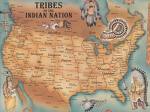


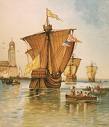








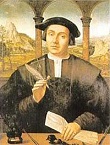








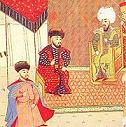




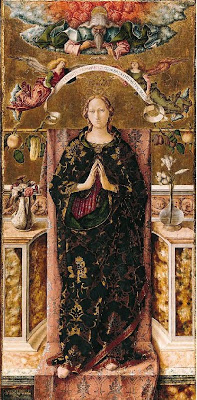
1492 The first day of the Jewish Passover falls during a blood-red moon; next 1948, 1967, 2014, 2015. Just what they need, illegal immigrants from Europe? The pop. of North Am., which peaked in 3,000 B.C.E. and stayed constant until this year suddenly halves, then soon rebounds?; pop. of the American Continent (North and South America): 15M-100M, incl. 7M-45M in South America, 7M-30M in Mexico and the Caribbean islands, and 1M-18M in the U.S. and Canada; they speak 1K+ languages, and are organized into 500+ tribes, ranging from the Inca in Peru, the Arawakan-speaking tribes around the Caribbean Sea, incl. the Taino (AKA Lucayans in the Bahamas) in the West Indies and Fla., the Mayans in Central America (Mesoamerica), the Aztecs in Mexico, ruled by emperor Ahuizotl (-1502), the Zapotecs in the Oaxaca Valley of SE Mexico, the Chichimeca tribes in the Gran Chichimeca plateau in NC Mexico, the Cumbia, Panteca and Coixcas in Cihuatlan (modern-day Zihuatanejo) in SW Mexico, the S Athabaskan-speaking Navajo (Navaho) ("great fields [of Tewa]"), Apache, and Quechan (Yuma) (pr. kwuh-tsan) in the SW U.S., the Lakota Sioux (Teton) ("adder", "enemy") and their enemies the Crow (Apsaaalooke) (Absaroka), the Tanoan-speaking Kiowas ("grizzly bear") on the Great American Plains, the Shoshone, Flathead (Salish) (the people"), Bannock, Ute, Arapahoe (Arapaho), Blackfoot, Dakota E of Detroit, Mich., and Sioux-speaking Mandan around the Missouri River; the Algonquian-speaking tribes in North America (known for the birch-bark canoe, and the tomahawk, from the Algonqian words "cutting utensil"), incl. the potlach-loving Kwakiutl in SW Canada, the Algonquian-speaking Anishinabe, Cheyenne (Suhtai) (Sutaio) (Tsitsistas) of the Great Plains, Anishinaabe (Algonquian)-speaking Chippewa (Ojibwe) (Ojibwa) around Lake Superior, Delaware (Lenape), ("real men") along the Delaware River, Iroquois-speaking Erie around Lake Erie, Sac (Sauk) and Fox around Lake Huron and Lake Michigan, Iroquois-speaking Huron (Wyandot) (Wendat), Iroquois (Haudenosaunee) ("people of the long house"), Iroquoian-speaking Tuscarora ("hemp gatherers") (Va.-N.C.), Algonquian-speaking Kickapoo ("stands here and there") (C and S Wisc.), Iroquois-speaking Mohawk ("people of the flint place") in the Mohawk Valley of upstate N.Y., Algonquian-speaking Narragansett ("on a small cape") in Rhode Island, Ottawa (Odawa) ("traders") on the Ottawa River in Ontario and Quebec, Alongquian-speaking Shawnee (AKA Savannah Indians), Iroquoian-speaking Susquehannock (Conestoga), and Wampanoag (Wopanaak) (Massasoit) ("eastern people") in E North America, the Athabascans, Eskimo (Inuit) ("eaters of raw flesh") ("the people"), Aleut (Unangan) (islands off the Alaskan Peninsula), Haida, and Tlingit in N Canada and Alaska; the Bella Coola (Nuxalk) in British Columbia (known for a religion with two heavens and two hells, and a female creator called Qama'itsa); in SE North America the 7-clan Iroquoian-speaking Cherokees of the Allegheny and Appalachian mountains in N.C., S.C., Tenn., Ga. and Ala., the Muskogean-speaking Creeks (Muskogee) (Muscogee) of Ala. and Ga. (#2 most powerful tribe S of New York after the Cherokees), the chickee-building Seminoles in Fla. (offshoot of the Creeks), the Yamasees, Chocktaws (Choctaws), Chickasaws, Natchez, and Houmas; the Siouan-speaking Yuchis (Uchees) (Euchees), and Catawbas ("people of the river"). The voyage of Christopher Columbus to the New World launches the Columbian Interchange/Exchange of diseases, crops, and livestock. 781 years, and it was more than worth it? On Jan. 2 the keys of Granada are surrendered to the forces of "Los Reyes Catolicos" (the Catholic Kings) Ferdinand II (1452-1516) and Isabella I (1451-1504) of Aragon and Castile by Boabdil (Muhammad XII) (1460-1533), who flees to Fez in N Africa, ending a 10-year effort by the Catholic kings, and becoming the final defeat of the Muslims in Spain, who invaded way back in 711, and were on the loser's team since the 1212 Battle of Las Navas de Tolosa, ending the Christian Reconquista (Sp. "reconquest") of Spain (begun 722); as Boabdil and his family leave the city, they pause at El Ultimo Suspiro del Moro (The Moor's Last Sigh) Bridge to look back at the glorious Alhambra ("red fortress"), and his mother tells him, "Weep like a woman for what you could not defend like a man"; meanwhile, wasting no time, after pulling strings with wealthy Marranos (closet Jews) Luis de Santangel(o), Gabriel Sanchez, and Juan Cabrero, auburn-haired (Marrano?) (front man for a Jewish conspiracy?) Christopher Columbus (1451-1506) meets with Ferdinand II and Isabella I in the Alhambra in Granada to beg for support for his proposed expedition to Cathay via the new improved westward ho route, promising to bring back gold and silver to finance an expedition to reclaim the Holy Land for Dear Christ, but they don't go for it, and he finally gives up and starts back for France to give their king the chance to become the next rich and admired Christian hero, but Isabella she-ain't-called-the-Catholic-for-nothing changes her mind at the last minute and sends messengers to stop him at the Bridge of Pinos, and they sign an agreement on Apr. 17, and the rest is, er, history - now America's ass is grass and whitey's got the lawnmower? Columbus was probably a secret Jew, a front man like English actor Sir Ben Kingsley (1943-) in the 1993 Steven Spielberg flick "Schindler's List", or maybe a Christian Jewish sympathizer like Oskar Schindler (1908-74) himself. Two, two, two expulsions in one, or, You must really try these strawberries and blueberries, we can take care of you wandering Jews? On Feb. 1 Spanish inquisitor-gen. Tomas de Torquemada (1420-98) gives Spanish Jews 3 mo. to accept Roman Catholic Christinsanity, er, Christinanity, er, Christianity or leave the country, and when they prove stiff-necked like always, on May 1 (Omer 19) Catholic Kings Ferdinand II and Isabella I order the Expulsion of the Spanish Jews, incl. all 250K non-converted Swine from Spain (50K families); after frantically trying to get something of value for their possessions (exchanging a house for an ass, a vineyard for a piece of cloth, etc.), and swallowing their gold and silver coins before going through custom posts, the last boatload leaves on Aug. 3; the ban on Jews is not lifted until 1968; Portuguese-born Jewish royal adviser Isaac Abravanel (1437-1508) is expelled; a massive number of Sephardic Jews migrate to N Africa, where they find themselves more educated, connected, and sophisticated than the Muslims, finding toleration and moving into govt. positions, which ends up stretching Muslim tolerance; many emigrate to the Ottoman Empire, where Sultan Beyazid II welcomes them into Constantinople, Izmir, Salonika, and other cities in Anatolia, the Balkans and Arab lands; others emigrate to England and Am. - no shortage of bankers, doctors, and lawyers now? On Apr. 26 Lorenzo the Magnificent de' Medici (b. 1449) dies after he falls ill and his physician gives him a potion containing ground pearls, and then calls "little friar" Girolamo Savonarola to his deathbed, only to be damned?; the Golden Age of Florence ends; he misses the New World by 6 blinkin' mo.?; his son Piero di Lorenzo de' Medici (1471-1503) becomes ruler of Florence (until 1503), and proves to not be so magnificent, becoming easy meat for Savonarola; Sandro Botticelli sees the light and becomes a good Christian again, becoming a follower of Savonarola by 1497 and turning his religious paintings mystical? Ouch, it just stinks? On May 31 Pope (since 1484) Innocent VIII (b. 1432) solemnly receives the Holy Lance, which Sultan (Grand Seignior) Bajazet II had surrendered to the Crusaders (it now sits in St. Peter's?), then dies on July 25, and on Aug. 11 his nephew Rodrigo (Roderigo) Borgia (Borja y Borja), a Catalan Spaniard from Valencia (father of Lucrezia Borgia) bribes enough cardinals to be elected Pope (#214) Alexander VI (1431-1503); on Aug. 26 he is invested in the Lateran after the most sumptuous ceremony in papal history; he committed his first murder at age 12; by this time he is father of at least seven children out of wedlock, four by longtime mistress Vannozza (Giovanna) dei Cattanei (1442-1518), which he advances unashamedly; his mistress since 1489, 18-y.-o. Giulia Farnese (1474-1524), whose long golden hair reaches to the floor is dubbed La Bella and the Bride of Christ; "Ten papacies wouldn't have sufficed to satisfy all his cousins" as he hands out lucrative posts to them. On June 7 king (since June 25, 1447) Casimir IV (b. 1427) dies, and his eldest son John Albert becomes Jan I Olbracht (John I Albert) (1459-1501), king of Poland (until June 17, 1501), while his 2nd son Alexander I Jagiellon (1461-1506) becomes grand duke of Lithuania (until Aug. 19, 1506); meanwhile Ivan III of Moscow forms an alliance with Crimean khan (since 1466) Menli I Girai (Giray) (1445-1515) and invades S Lithuania in an attempt to increase his domains, starting the First Russian (Muscovite)-Lithuanian War (ends 1494). How to lose 93 million friends in ten days, or, When he started out he didn't know where he was going, when he got there he didn't know where he was, and when he got back he didn't know where he'd been, until he looked between his legs? The biggest TV reality show without teleprompter or cue cards? On Aug. 3 (same day the Jews are expelled from Spain by Ferdinand II and Isabella I) after receiving 17K ducats from baptized Jewish finance minister Luis de Santangel (-1498) (who talked the monarchs into it), and allegedly receiving a vision from the Holy Spirit to bear Christ to the West Indies (or a vision from the Devil to carry his Catholic Church there?), writing "I could feel his hand upon me to sail to the Indies... There was no question that the inspiration was from the Holy Spirit", 41-y.-o. Christopher (Gr. "Christ-bearer") Columbus (Lat. "dove") (1451-1506) (who is really working for the Illuminati, since his real name is Cristobal, i.e. "anointed of Baal or Satan", plus Colombo (It.) = Colom (Catalan) = Colon (Sp.) = anus?, and Lat. "paloma" = dove = penis?) (mixed up with Genoese peasant weaver Cristoforo Colombo?), and who has never been farther E than the Aegean Sea begins his First Voyage for Asia by going W instead of E, setting sail from Paloma, er, Palos, Spain for the island of La Gomera in the Canary Islands to pick up wine and water, getting into a romance with gov. Beatriz de Bobadilla y Ossorio (1462-1501) and staying for 1 mo. (returning in 1493 and 1498, when she marries somebody else), who gives him sugar cane cuttings, after which he sails for the "West Indies" (West Asia), thinking that his voyage will lead him to Cathay (China), Cipango (Japan), the Spice Islands (the Moluccas), then India in three ships with a total crew of 88, incl. five Marranos (converted Jews), incl. interpreter Luis de Torres, surgeon Marco, physician Bernal, and sailors Alonzo de la Calle and Gabriel Sanchez (who later sells Columbus on the idea of capturing 500 Indians to sell as slaves in Seville, becoming the beginning of Am. slavery); the crew is really Catalonian?; the ships incl. the caravel Pinta (Sp. "pint, spotted one") (the fastest), piloted by Martin Alonzo Pinzon (Pinzón) (1441-93), the caravel Nina (Niña) (Sp. "girl") (real name Santa Clara) (Columbus' favorite ship), piloted by his brother Vincente Yanez Pinzon (Yáñez Pinzón) (1461-1515) (who ends up going on all five of Columbus' voyages), and the 235-ton carack (nao) Santa Maria (real name Mariagallante = Gay Mary), Columbus' flagship (crew of 70) (Columbus calls it "La Capitana") (the Santa Maria was used in the 3rd voyage, but Christopher's son Ferdinand writes a history which starts the confusion going); since there are no watches yet to determine longitude at sea, Columbus sails first into the latitude of Cipango (Japan) (the Tropic of Cancer) and proceeds straight W, being helped greatly by the trade winds, which he discovers as he goes; after about 1 mo. at sea, the crew began getting nervous, so instead of continuing west and making landfall in the Carolinas, Columbus seizes on a sighting of a flock of birds migrating to the SW, changing course to follow and instead heading for the West Indies. On Aug. 31 German humanist scholar Conradus Celtis (Conrad Celtes) (1459-1508), whom HRE Frederick III had appointed poet laureate at the urging of Frederick of Saxony gives a famous speech to students in Ingolstadt, calling on Germans to rival the Italians in letters and learning. The Ultimate Thank God It's Friday? On Oct. 10 Columbus' crew nearly mutinies, and makes Columbus promise to return home if land isn't sighted in two days (sounds like a fairy tale concocted later to make them seem to enjoy divine favor?); on Oct. 11 (10 p.m.) a UFO is sighted, consisting of "a light glimmering at a great distance", which disappears and reappears several times, moving up and down "in sudden and passing gleams" - let me guess, a welcome signal from ETs? On Oct. 12 (Oct. 22 Gregorian) (Fri.) (2:00 a.m.) (after 36 days and 2.6K mi.), Pinta's crow's nest sailor Rodrigo de Triana (Juan Rodrigo Bermejo) (1469-?) does guess what, you guessed it, sights land (and later gets so pissed-off at not being given a reward that he moves to Africa and converts to Islam?), and Christopher Columbus (1451-1506) and his crew anchor at San Salvador (Sp. "Holy Savior") (Watlings) Island (called Guanahani by the aborigines) in the Bahamas just N of the Tropic of Cancer, at 23.5 deg. N 75 deg. W (the log books say 24 deg. N 75.5 deg. W) (named after pious pirate Watling, who forbade pillaging on Sundays, the residents renaming it San Salvador in 1926 to claim it as the place of Columbus' first landfall after 434 years of controversy, but it is never conclusively decided, with Cat Island and Samana Cay proposed), and Columbus dresses in full admiral's regalia to take possession of the new land in the name of Ferdinand and Isabella; having never seen a ship, the natives don't see them until a shaman convinces them that they're real, after which they greet Columbus with warm hospitality, causing him to write "They willingly traded everything they owned... They do not bear arms... They would make fine servants... They could easily be made Christians... With fifty men we could subjugate them all and make them do whatever we want"; after the natives present them with tobacco leaves, which they discard, they sail SW through the Great Bahama Bank, landing on Cuba on Oct. 17, thinking it is the Chinese continent, searching in vain for the magnificent cities described by Marco Polo; on Oct. 20 Columbus writes "I shall set sail for another very large island which I believe to be Cipango, according to the indications I receive from the Indians on board", which proves to be Hispaniola, and he finally lands on Haiti on Dec. 5. On Nov. 3 after invading France to punish it for supporting Perkin Warbeck, Henry VII of England forces them to agree to the Peace (Treaty) of Etaples (Étaples) (official end of the Hundred Years' War), in which France expels Warbeck and pays England an indemnity of £159K. On Nov. 7 a 250-lb. meteorite lands in the village of Ensisheim, France in NE France, becoming the oldest meteorite with a known date of impact; it is housed in the town's museum La Musee de la Regence, becoming a tourist trap. In Nov. a gift of tobacco leaves from the Arawaks (Aruacans) is kept this time after Santa Maria crewman Rodrigo de Jerez learns to smoke from the natives, and brings back the habit to his hometown of Ayamonte, causing his wife to denounce him as a man who "swallows fire, exhales smoke, and is surely possessed by the devil", after which he is imprisoned by the Spanish Inquisition for seven years, by which time the super-addictive habit of smoking has caught on. On Dec. 21 (St. Thomas' Day) Columbus discovers Port St. Thomas in Haiti, and on Dec. 22 he has his first meeting with Marien chief (cacique) Guacanagaric (Guacanagarix) (Guacanagari), who allows him to found the settlement of La Navidad; too bad, the settlers are killed by a rival tribe before Columbus returns on his 2nd voyage. On Dec. 24 (Dec. 15 Old Style) Columbus writes in his journal that he is very impressed by the aborigines, who are of "pleasing appearance with fine features and medium height with muscular bodies", adding, "A better race there cannot be, and both the people and the lands are in such quantity that I know not how to write it... All here have a loving manner and gentle speech". On Dec. 25 the Santa Maria sinks off Hispaniola (La Espanola) (Haiti); it was first shot with a cannonball by Columbus' flagship to disable it on Caracol Beach, and rechristened Ft. Natividad, housing the men Columbus left behind until the natives attacked and burned it?; he left the men behind to force Isabella into financing a 2nd voyage?; her overseers, the fleet's master at arms, comptroller, and secy. were left behind to avoid being contradicted when he told Isabella he had discovered India? - she had to leave to give birth to Santa Claus? On Dec. 26 Columbus writes in his journal that he had been hoping to find gold "in so great quantity that the Sovereigns within three years would undertake and prepare to go and conquer the Holy Places [Holy Land]"; chickens and rats are introduced to America; smallpox is also introduced to native Ams. as a get-unwell card by 1518; Jews are also introduced next year, with Portuguese Jews settling in St. Thomas Island, later becoming the first large plantation owners, running sugar factories with 3K African slaves; too bad, when the new discovery doesn't fulfill the original mission of furnishing a route to India and China, desperation sets in, causing the need to milk the New World for plunder and profit to take over, resulting in a mean cold systematic mass murder machine that goes on for cents. and reduces the native pop. to almost nil; Columbus hangs natives 13 at a time in honor of Christ and the 12 Apostles? Vasco da Gama (1460-1524) directs the defense of the Portuguese colonies from the French on the coast of Guinea. Duke Albert of Bavaria joins the Swabian League, undertaking to uphold the authority of the Holy Roman Empire. The Ottomans under Bajazet II of Turkey invade Hungary, and defeat them at the Battle of the Save River. Sikander II Lodi, sultan of Delhi annexes Bihar in NE India (capital Patna). The 11K-man army Duchy of Courland in modern-day Latvia is forced to pay half its profits to the Teutonic Order, causing it to secretly parley with King John Albert of Poland for help in exchanging for helping them acquire the order's Baltic territories. King (since 1471) Dhammazedi (b. 1409) dies, and his eldest son Binnya Ran II (1469-1526) becomes Hanthawaddy king #17 of Burma (until 1526), immediately putting all royal offspring to death then becoming revered for his gentle rule. A papal letter says that Greenland no longer has any priests, and that believers are reduced to venerating the altar cloth; the colony is never mentioned again, and all contact is lost in the same year that America, a Greenlander discovery is rediscovered. The expulsion of the Sephardic Jews from Spain causes their influence in Jewry to wane, permitting the Qabala (Kabbalah) to begin to replace the Hakirah (Mishna Torah) in mainstream Jewish theology? A bunch of Jews hike from Spain to Salonica, Greece; in 1943 the Nazis deport them all to Auschwitz. German Black Forest humanist Johann Reuchlin (1455-1522) begins the study of Hebrew, incl. the Torah and Talmud, which pisses off Jews and Catholic Dominicans alike, causing him to attack the Roman Catholic Church, although he never goes for that Reformation thang of his nephew Melanchthon? - it's important to me that you know you are free, cause I never wanna make you change for me? Antoine de Ville, lord of Domjulien and Beaupre leads a team that becomes the first to ascend 2,085m Mont Aiguille in SW France 36 mi. S of Grenoble, using ladders and ropes, launching the sport of mountaineering? Henry VII issues a license to Flemish brewer John Merchant to export large quantities of an "ale called beere", requiring it to be of good quality, with inspection by Geffrey Gate, owner of the Red Lion Brewery in East Smithfield, London on the Thames River between the Tower of London and Wapping; Gates goes on to destroy the brewhouses twice due to weak beer; in 1615 the brewery is leased by John Parsons for $44/year for 31 years, after which it stays in the family for three more generations, with their beer becoming known as Parson's Black Champagne; in 1694 the Red Lion Brewery is assessed as the most valuable brewery in London; his son Sir John Parsons Jr. (1639-1717) is elected lord mayor of London in 1703; in 1717-41 his Jacobite son Sir Humphrey Parsons (1676-1741) becomes mgr., going on to be elected lord mayor of London in 1730 and 1740, and obtain a privilege of supplying the French court in 1730; in 1779 the brewery is acquired by Henry Goodwyn, followed in 1802-1933 by the Hoare banking family, who run Hoare's Bank at the sign of the Golden Bottle in Fleet St. Architecture: Bramante starts building the choir and cupola of St. Maria delle Grazie in Milan, becoming his masterpiece, and the first time candelabrum shafts are used as an exterior decoration to pilasters (finished 1498). German sculptor Veit Stoss (1438-1533) sculpts the red marble Tomb of Casimir IV in Crakow Cathedral; it is opened by 12 researchers on Friday the 13th of April, 1973, and 10 die from fungi. Inventions: German geographer Martin Behaim (1459-1507), who accompanied Diogo Cao in his 2nd expedition to West Africa in 1485-6, then was knighted by king John II of Portugal builds the Erdapfel (Earth Apple), the first globe of the Earth in Nuremberg, using the same sources as Christopher Columbus, showing Japan 1.5K mi. E of Europe - looking pretty good to Spanish Jews? Nonfiction: Anon., Apicius Culinaris (Milan); 4th-5th cent. C.E. Roman cookbook, printed by Blasius Lancilotus; a rev. ed. is printed in 1498 by Guiliermus de Signerre Rothomagensis. Elio Antonio Nebrija, Latin-Spanish Dictionary. Art: Sandro Botticelli (1445-1510), 96 Illustrations for Dante's "Divine Comedy" (1492-5). Carlo Crivelli (1430-95), The Immaculate Conception. Ghirlandaio (1449-94), La Visitation Entre Marie Jacobie et Marie Salome. Novels: Diego de San Pedro (1437-98), La Carcel de Amor (The Prison of Love); one of the first Spanish novels of courtly love - Courtney Love in Nirvana? Births: Spanish humanist scholar Juan Louis Vives (d. 1540) on Mar. 6 in Valencia. French queen ("the First Modern Woman" - Samuel Putnam) Margaret of Navarre (Marguerite d'Angouleme) (d. 1549) on Apr. 11 in Angouleme; sister of Francis I of France; wife (1509-25) of Charles IV d'Alencon (1489-1525) and (1525-49) Henry II of Navarre (-1555); mother of Jeanne III of Navarre (1528-75) (mother of Henry IV); writer and patron of lit., and protector of Protestantism. Italian satirical writer Pietro Aretino (d. 1556) on Apr. 20 in Arezzo; illegitimate; the first Euro journalist; inventor of modern literate porno? German-Danish statesman-gen. (Protestant) Johan (Johann) Rantzau (d. 1565) on Nov. 12 in Steinburg (near Itzehoe); father of Heinrich Rantzau (1526-98) and Paul Rantzau; great-grandfather of Josias von Rantzau (1609-50). Swedish regent (1513-20) Sten Sture the Younger (d. 1520); son of Svante Sture. Swiss-German composer Ludwig Senfl (d. 1543). German composer and Protestant cleric Benedictus Ducis (d. 1544). Italian Renaissance Mannerist painter-architect Giulio Romano (Giulio Pippi de' Giannuzzi) (d. 1546) in Rome; Raphael's chief pupil and heir. English physician-naturalist Edward Wotton (d. 1555) in Oxford. German arithmetician Adam Riese (Ries) (d. 1559) in Staffelstein, Franconia; writes in German not Latin. English cloth merchant (lord mayor of London in 1553) Sir Thomas White (d. 1567) in Reading, Berkshire; knighted in 1553. Ottoman naval officer-artist Nigari (Reis Haydar) (Haydar Ra'is) (d. 1572). Spanish soldier-historian Diaz del Castillo Bernal (d. 1581). Deaths: Burmese king (1471-92) Dhammazedi (b. 1409) in Pegu. Persian poet Jami (b. 1414). Italian painter Piero della Francesca (b. 1420). Polish king (1447-92) Casimir IV Jagiellon (b. 1427) on June 7 in Hrodna (Belarus). English queen (1464-83) Elizabeth Woodville (b. 1437) on June 7/8 in Bermondsey Abbey. Scottish poet Blind Harry (b. 1440). Spanish nobleman Beltran de la Cueva, 1st duke of Albuquerque (b. 1443) on Nov. 2 in Cueva. Florence godfather Lorenzo de' Medici (b. 1449) on Apr. 8. French-Flemish composer Antoine Busnoys (Busnois) (b. ?). Songhai ruler Sonni Ali (b. ?).





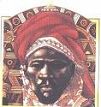

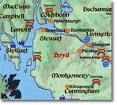
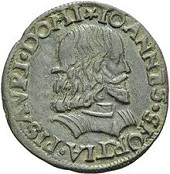
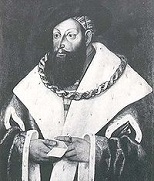




1493 Veni vidi vici? On Jan. 16 Christopher Columbus departs from Hispaniola for Spain, first seeking the latitude of Palos to catch the westerly winds; his voyage path has a big bend caused by his compass beginning to point east of north instead of west of north?; he arrives at Lisbon on Mar. 4, returns to Spain from his first voyage to the Western Hemisphere on Mar. 15 (the Ides of March), and is hailed as a hero (like Caesar?); he brings 10 live aborigines with him, parading them along with parrots through the streets during his triumphal procession to see Ferdinand II and Isabella I in Barcelona (thus becoming the New World's first slave trader); in Apr. the big news is announced in the banquet hall of Barcelona; four of the Indians get sick so Columbus leaves them in the care of his Florentine backer Gianetto Berardi (-1495) in Seville (who is letting Amerigo Vespucci live with him at the time); the gold he brings back is used to gild the ceiling of the Church of Santa Maria Maggiore in Rome. On Mar. 4 the debut issue of the Spanish magazine Internat. Press Release pub. Colon's First Letter in Lisbon, Portugal, a letter sent to Luis de Santangel, clerk of the Racion de la Corona de Aragon by Don Cristobal Colon, new Adm. of the Ocean Sea, Viceroy and Gov. of the Indies, containing the soundbyte: "Sir, Since I know that you will rejoice with the glorious success that our Lord has given me in my voyage, I write this to tell you that in 33 days I sailed to the Indies"; the letter was interepted by Barcelona printer Pedro Posta, who mispells his name as Colom, after which it is translated by Aliander de Cosco into Latin and pub. in Rome on Apr. 29, changing his name to Columbo, causing that name to spread over Europe after 11 eds. are pub. in 1493 and six more by 1497. On May 4 (June 28 Gregorian) Pope Alexander VI issues the bull Inter Caetera Divina ("Among other works"), dividing the New World between Portugal and Spain along a N-S line 100 leagues W of the Cape Verde islands, giving Portugal Africa and the E side of South America, but since they didn't realize yet that most of South America lies way E of North America, Spain ended up with most of the New World in both North and South America. On May 23 to restore Margaret of Burgundy's dowry after Charles VIII married Anne of Brittany instead of Margaret of Austria, Maximilian I forces him to agree to the Treaty of Senlis, which restores Artois and Franche-Comte to Mary of Burgundy's 15-y.-o. handsome son Philip I the Handsome of Castile, although Burgundy and Picardy remain French. On Aug. 19 HRE (since 1452) Frederick III of Hapsburg (b. 1415) dies, and his son Maximilian I (1459-1519) becomes the first to take the title of HRE-elect. On Sept. 9 the Battle of Krbava Field near modern-day Udbina in C Croatia sees Bosnian Sanjak Bey Hadim Yakup-Pasa with 8K Akincis (Ottoman light cavalry) returning from a pillage expedition to Styria and Croatian Zagorje smash a Croatian feudal army of 2K cavalry and 8K infantry under command of Ban Emerik (Mirko) Derencin (Imre Derencsenyi), killing 7K incl. virtually all the nobles, the rest along with Ban Derencin captured by the Turks and taken away for ransom; Croatia, which is a vassal of Hungary was broken militarily, causing many Croats to flee to Austria and Italy. On Sept. 24 Christopher Columbus begins his 33-mo. Second Voyage to the Caribbean in a grand fleet of 17 ships with 1.2K crew (incl. some free black Africans?), leaving the Canary Islands on Oct. 13, and arriving in the Bahamas in Nov., sighting Saint Martin Island on Nov. 11, becoming the first voyage to carry limes to prevent scurvy, planting the first sugar cane in the New World in Hispaniola, which has its first harvest in 1501, after which cane sugar mills are built in the 1520s in Cuba and Jamaica, along with hundreds in Brazil by 1540, causing a great need for African slaves to work the sugar cane fields, which leads to the Triangle Trade with Africa and Europe; he brings horses to the New World, albeit the West Indies only, leaving it to Cortez to bring them to the mainland in 1519; on Nov. 19 Columbus discovers Puerto Rico (Sp. "rich port") (Arawak name Boriquen), then reaches Espanola on Nov. 22, followed by La Navidad on Nov. 28, finding that 40 men previously left there are all dead, and on Dec. 7 founds the town of La Isabela on the N coast of Santo Domingo, becoming the first planned colonial town in the New World, which only lasts a few years after mismanagement, disease, hurricanes, and mutiny; he then sets off to the SE and discovers the Virgin Islands (almost 50 cays and islands), followed by St. Christopher (Kitts) (Liamuiga), Nevis, Antigua and Barbuda, and Montserrat (Sp. "saw-toothed mountain"), the twin butterfly-wing islands of Guadeloupe (Carib "Karukera" = island of beautiful waters) (and his first pineapples), Dominica (Lat. "Sunday") (discovered on Sun., Nov. 3) (home of Caribs who practice ritual cannibalism, which the Euros exaggerate to justify inhuman treatment of all Indians), and St. Thomas; he also discovers Jamaica, 90 mi. S of Cuba and 100 mi. W of Haiti, home to the unlucky Arawaks, and names it St. Iago (James); he first encounters the canoe (Sp. canoa) in use by Caribbean aborigines, whom he calls cannibals, because he observes the ferocious man-eating Caniba chowing down on tasty peop and hume? - stand by your man? Urged on by Duke Ludovico Sforza the Moor of Milan, the last patron of the relentlessly persecuted Renaissance, who is bothered by his isolation after the death of Lorenzo de' Medici, Charles VIII of France heeds the appeals of Neapolitan refugees and prepares an invasion of Italy to destroy Italian autonomy (begins 1494). The Turks invade Dalmatia and Croatia. The Jews are expelled from Magdeburg. The Statute of Piotrkow grants the Polish aristocracy privileges at the expense of burghers and peasants; the old town of Piotrkow (Petrokov) in Lodz Province near the Pilica River 90 mi. SW of Warsaw becomes the place Polish kings are elected through the 16th cent. The first Bundschuh peasant revolt (named after their tied working boots) begins in Alsace and SW Germany. It all happened in the kitchen? The proposed reforms of the Dominican Order in Tuscany by Dominican friar Girolamo Savonarola (1452-98) are accepted by Pope Alexander VI, and he is appointed vicar-gen., going on to have hos beaten and homos burned, and send gangs of militant youths out to enforce his reign of terror, er, kingdom of God on Earth; Pope Alexander VI absolves Giovanni Pico della Mirandola (1463-94) (last of the Schoolmen) of heresy, and appoints his 18-y.-o. son Cesare Borgia (1475-1507) as a cardinal, becoming notorious for licentious habits and violent temper; Mirandola visits Florence, and is turned on by religious reformer Girolamo Savonarola and his prophecies of the coming Antichrist and how Florence will soon become "the reformation of all Italy" and its people will become God's elect, promising to give away his possessions and become a promising to give away his possessions and become a wandering preacher, but dies next year before he can do it. Pope Alexander VI's 13-y.-o. probably virginal daughter Lucrezia Borgia (1480-1519) is married in the papal palace to Giovanni Sforza, lord of Pesaro in a long white gown whose train is borne by a black boy, followed by 150 women (incl. the pope's mistress Giulia Farnese) to the papal throne surrounded by 11 cardinals; the marriage is annulled in 1497 - the black boy got to her? wandering preacher, but dies next year before he can do it. Scottish king James IV's first important mistress Marion (Margaret) (Margot) Boyd, niece of Archibald Douglas, 5th earl of Angus bears him a son, Alexander, whom he makes archbishop of St. Andrews at age 11; she also bears daughter Catherine, who marries James Douglas, 3rd earl of Morton. Askia Mohammed Toure (1443-1538) becomes king of the Songhay (Songhai) Empire in W Sudan, growing it to the largest country in West African history (until ?), expanding trade with Europe and Asia, and establishing Islam as the official religion, spurring a cultural revival. Maximilian I makes Paul Hofhaimer (1459-1537) his court organist and Heinrich Isaak (1450-1517) his court composer. Dutch printer Gotfried van Os, who calls himself Gotfred of Ghemen begins pub. books in Copenhagen. There was a gypsy who had a brother who died, so which brother died? The first Hebrew printing press in Constantinople is founded by two Jewish exiles from guess where (Spain), Samuel ibn Nahmias and David ibn Nahmias, and another one is founded later in Salonika; too bad, there is a Muslim ban on printing in Arabic and Turkish until the 18th cent.? Duke George "the Rich" (1455-1503) of Bavaria-Landshut extends the 1447 Munich beer purity ordinance to the duchy of Landshut in C Bavaria. Architecture: The Cathedral of Toledo (begun 1226) is finished after the vaults of the central nave are finished. Nonfiction: Jacques Lefevre d'Etaples, Paraphrasis in Aristotelis Octo Physicos Libros. Henry Parker, Dialogue of Dives and Pauper; first dated book pub. by Richard Pynson. Vu Quynh, Linh Nam Chich Quai; treasury of Vietnamese folklore. Hartmann Schedel (1440-1514), The Nuremberg Chronicle; illustrated history of the world from Creation in Latin and German. Inventions: Leonardo da Vinci designs the Airscrew, the first flying machine, but never builds a working model - suggested by his sexual orientation? Art: Albrecht Durer (1471-1528), Self-Portrait Holding a Thistle; age 22; makes another later at age 28. Filippino Lippi (1457-1504), Saints Paul and Frediano (panel). Il Perugino (1445-1523), Pieta (Pietà) (1493-4) (Florence). Pinturicchio (1454-1513), Six Frescoes in the Vatican Library (1493-8). Tilman Riemenschneider (1460-1531), Madonna (sculpture) (Wurzburg Cathedral). Births: German viceroy of Valencia (1523-5) margrave Johann of Brandenburg-Ansbach (d. 1525) on Jan. 9 in Plassenburg; son of Margrave Frederick I and Sophia of Poland; 2nd husband of (1519-25) Germaine de Foix (1488-1538). French marshal-constable Anne de Montmorency (d. 1560) on Mar. 15 in Chantilly. Italian poet Agnolo Firenzuola (d. 1543) on Sept. 28 in Florence. Italian "Hercules and Cacus" Renaissance sculptor-painter Baccio (Bartolommeo) Bandinelli (Brandini) (d. 1560) on Oct. 17 in Florence; known for insane jealousy of Michelangelo and Benvenuto Cellini. German-Swiss Renaissance physician-philosopher-alchemist ("the Father of Toxicology") (grandfather of pharmacology) ("the Devil's Doctor") Philippus Paracelsus (Lat. "Greater than Celsus") (Aureolus Theophrastus Philippus Bombastus von Hohenheim) (d. 1541) on Nov. 11 (Dec. 17?) in Einsiedeln; student of Johannes Trithemius (1462-1516). German Bavarian pure beer-loving duke (1508-50) and co-duke (1516-45) William IV (d. 1550) on Nov. 13 in Munich; son of Albert IV and Kunigunde of Austria (daughter of HRE Frederick III); brother of Louis X (1495-1545). Scottish archbishop of St. Andrews (1504-13) Alexander Stewart (d. 1513); bastard son of James IV and Marion (Margaret) Boyd, niece of the 2nd wife of Archibald Dougls, 5th earl of Angus. Swedish "Swedish Chronicle" Reformation writer-reformer ("the Swedish Martin Luther") Olaus (Olavus) Petri (Persson) (Petersson) (d. 1552) in Orebro; educated at the U. of Leipzig, and U. of Wittenberg. German Renaissance painter Barthel Bruyn (the Elder) (d. 1555) in Wesel (Cologne?). Swiss Protestant patriot writer (former Cluniac monk) (hero of Byron's "Prisoner of Chillon") Francois Bonivard (d. 1570) in Seyssel; of an old Savoyard family; starts out Roman Catholic then after four years of imprisonment in the Castle of Chillon on Lake Geneva near Montreux goes Protestant. Dutch (Flemish) religious poet Anna Bijns (d. 1575) in Antwerp. Spanish physician-botanist Nicolas (Nicolás) Bautista Monardes (d. 1588) in Seville. Deaths: Austrian German king (1440-86), and HRE (1452-93) Frederick III of Hapsburg (b. 1415) on Aug. 19 in Linz - how is Austria going to rule the world when it has just doubled in size and they didn't get any of the new parts? Transylvanian prince (1479-93) Stephen V Bathory (b. 1430).




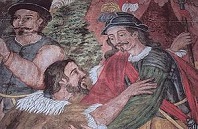


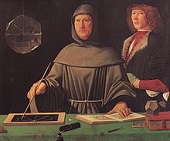
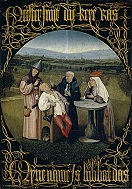



1494 The plague returns to Iceland, killing half its pop. As the year begins Italy is composed of the Kingdom of the Two Sicilies (Naples) in the S, the Papal States from Rome NE to Ravenna, the Repub. of Florence, the Repub. of Genoa (incl. Corsica), the Repub. of Siena, the Venetian Repub. (incl. Istria and Dalmatia on the E side of the Adriatic Sea), the Duchy of Ferrara, the Duchy of Milan, the Duchy of Modena, the Duchy of Savoy (bordering France), the Marquisate of Mantua (Mantova), and the Marquisate of Saluzzo. They're thinking of banning toy guns, but keeping the real ones? On Jan. 25 the Italian Wars, a power grab by France and Spain over the states of Italy begin (end 1559) when Ferdinand I Ferrante Ferdinand I Ferrante (b. 1423) dies, and his Renaissance-loving humanist eldest son Alfonso II (d'Aragon) (1448-95) becomes king of Naples (the Two Sicilies), which is bankrupt, and despite the pope coronating him on May 8, Charles VIII of France reasserts the Angevin claim to Naples and the title of king of Jerusalem which goes with it, and invades Italy in Sept. in the Valois Blitzkrieg of 1494 with a fast-moving force; "The French came upon all this like a sudden tempest that turns everything upside down" (Francesco Guicciardini); the news causes European states to shift into high gear in order to modernize? On May 31 the First Battle of Acentejo on Tenerife in the Canary Islands is a V by the native Guaranches over the Spanish under cruel Javier Alonso Luis Fernndez de Lugo (-1525), (who conquered La Palma Island in 1492-3), who lose 900-1K casualties, becoming the greatest Spanish D during their Atlantic expansion; after a rock knocks out most of his teeth, de Lugo escapes with his life by ditching his red Adelantado cape and dressing as a common soldier; on Nov. 14-15 after assembling a 1K-man army he defeats the Guaranches at the Battle of Aguere, followed on Dec. 25 at the decisive Second Battle of Acantejo; in 1496 de Lugo finishes conquering Tenerife, founding the town of Santa Cruz de Tenerife and ruling the natives like er, dogs. On June 7 Spain and Portugal sign the Treaty of Tordesillas, moving the pope's demarcation line 170 leagues to the W. On June 24 Italian explorers John Cabot (1450-98) and his son Sebastian Cabot (1476-1557) discover North Am.?; he is actually Italian sea captain Giovanni Caboto from Genoa, changing his name to an English one to be PC? On Oct. 21 Gian Galeazzo Sforza (b. 1469) dies in captivity, and his uncle-usurper (supposedly regent) Ludovico Maria Sforza the Moor (1452-1508) becomes duke of Milan; in Mar. HRE Maximilian I marries Gian Galeazzo Sforza's aunt Bianca Maria Sforza (1472-1510). On Nov. 17 Charles VIII of France enters Florence after expelling Piero de' Medici, then enters Rome, causing Pope Alexander VI to take refuge in Castel Sant'Angelo; the Medicis lose power in Florence and begin an 18-year exile caused by Girolamo Savonarola; Michelangelo begins traveling; "Little friar" Girolamo Savonarola sets up a theocracy in Florence, urging followers to burn their worldly goods in "the bonfire of the vanities", enjoying large public BBQs of hated Medici items such as books, figurines, wigs, cosmetics and jewels, with the clear intention of breaking with the classical pagan past dredged up by the Renaissance; Sandro Botticelli hurls his own paintings into the fire; Savonarola's fanaticism stirs up intense hatred by his opponents, incl. Pope Alexander VI, eventually threatening to drive Europe to the verge of collapse? HRE Maximilian I recognizes Richard, duke of York, er, Perkin Warbeck as king of England; meanwhile Henry VII sends soldier-diplomat Sir Edward Poynings (1459-1521) to Ireland as new English viceroy to replace pesky Earl Gerald of Kildare, who had been supporting Perkin Warbeck, making sure the new viceoy is purely English and will reestablish English control against the sell-out Irish-loving longtime Anglo-Norman residents; Poynings summons the Irish Parliament to Drogheda and informs them that they will be subservient to the English Parliament, and forces them to enact Poyning's Law (Statute of Drogheda) (repealed 1782) to Anglicize them, reducing the power of Anglo-Irish lords and providing for the defense of the English Pale while resurrecting and reconfirming the 1366 Statue of Kilkenny enforcing segregation and confirming the Irish as second class in their own country; the Irish Parliament is made subservient to the English king, requiring him to be informed of proposed legislation and then license Parliament to meet if he approves it; after a time Kildare, the most powerful of the Irish nobles is reinstated on a short leash, and the Pale prospers while those outside the Pale, ahem it takes until the 1800 Acts of Union to repeal it. Ivan III of Moscow closes the Hanseatic trading office in Novgorod. Aemilius Paulus of Verona is appointed historiographer royal to Charles VIII of France. Yet another boy Messiah appears on the scene, this time in Persia? 7-y.-o. Ismail (Ism'ail), son of Haydar becomes head of the persecuted Shiite Safavid order, fleeing from Ardabil to Gilan and finding asylum with a local Shiite ruler for five years, during which time he develops ideas regarding his divine leadership and messianic mission, and makes plans to kick White Sheep butt bigtime to prove it? The First Russian-Lithuanian War (begun 1492) ends with a truce and the marriage of Ivan III's daughter Elena to grand duke Alexander. The Pots of Luck goods lottery is introduced in Leipzig, Germany as a popular entertainment. The U. of Pisa revolts and moves to Florence. Christopher Columbus sends 500 Am. slaves to Spain for sale in Seville. Songjong II dies, and his eldest son Yeonsan-gun (Yonsan Gun) (1476-1506) becomes Yi king of Korea (until Nov. 20, 1506), going on to become the worst tyrant in Joseon Dynasty history, launching two bloody purges of the seonbi elite, forcing 1K woman from the provinces into palace prostitute, and seizing the Seonggyungwan study hall for use as a bordello. The Kingdom of Saloum (ends 1969) in modern-day Senegal is founded as a sister kingdom to the Kingdom of Sine, with capital at Kahone. German artist Albrecht Durer (Dürer) (1471-1528) returns to the studio of his teacher Michel Wohlgemuth after a tour of Europe (Colmar, Basel, Venice), and works there until 1497, when he establishes his own studio - somebody help me, I can't escape myself? The first mention of malted barley whiskey production in Scotland. Nonfiction: Jean Mauburnus, Rosetum Exercitiarum Spiritualium; first systematic study of musical instruments. Luca di Pacioli (1445-1517), Summa de Arithmetica, Geometria. Proportioni et Proportionalita (Venice); the first textbook on modern accounting theory, incl. double-entry bookkeeping, causing him to be called "the Father of Accounting and Bookkeeping"; first printed use of +/- symbols for arithmetic? Johann Reuchlin (1455-1522), De Verbo Mirifico. Girolamo Savonarola (1452-98), Psalms; disses the Roman Catholic Church for its acceptance of astrology; "I say that astrology, since it tries to divine the future, is the cause of much superstition and heresy." Art: Hieronymus Bosch (1450-1516), Cutting the Stone; a surgeon wearing a funnel hat extracts the Stone of Madness (keye) from a patient's head using trepanation. Sandro Botticelli (1445-1510), Calumny; The Last Communion of St. Jerome. Il Perugino (1445-1523), Portrait of Francesco dell' Opera (Florence). Pinturicchio (1454-1513), Resurrection (Apostolic Palace, Vatican); contains the first known depiction of Native Americans, naked wearing headdresses. Leonardo da Vinci, Madonna of the Rocks (begun in 1483). Poetry: Matteo Maria Boiardo (1434-94), Orlando Innamorato; first poem to combine Arthurian and Carolingian romances, giving new life to the chivalrous epic; left unfinished at his death. Sebastian Brant (1457-1521), The Ship of Fools (Das Narrenschiff); satirical poem about the gradual advances of Islam on "sleeping" Christendom"; big bestseller; tr. into English by Alexander Barclay in 1509, and Henry Watson in 1517; "Our faith was strong in the Orient./ It ruled in all of Asia/ In Moorish lands and Africa./ But now [since the seventh century] for us these lands are gone... /We perish sleeping one and all/ The wolf has come into the stall/ And steals the Holy Church’s sheep./ The while the shepherd lies asleep./ Four sisters of our Church you find/ They’re of the patriarchic kind/Constantinople, Alexandria, Jerusalem, Antioch./ But they’ve been forfeited and sacked/ And soon the head [Rome] will be attacked." Walter Hylton (1340-96), Ladder of Perfection (posth.); by an Augustinian canon of Thurgarton, Nottinghamshire, England; first exhaustive work of ascetic mystical theology in English. Births: German physician-scientist ("Founder of Mineralogy") Georgius Agricola (Georg Bauer) (d. 1555) (Ger. "bauer" = farmer) on Mar. 24 in Glauchau, Saxony; not to be confused with Johannes Agricola (1494-1566) or Michael Agricola (1510-57). French Valois king #9 (1515-47) Francis (Francois) I (d. 1547) on Sept. 12 in Cognac, Charente; son of Charles d'Angouleme (1459-96) (1st cousin of Louis XII) and Louise of Savoy (1476-1531). Ottoman sultan #10 (1520-66) Suleiman (Suleyman) I (the Magnificent) (the Law Giver) (d. 1566) on Nov. 6 in Trabzon; son of Selim I (1465-1520); father of Selim II (1524-74). Spanish explorer Alonso Alvarez (Álvarez) de Pineda (d. 1520) in Aldeacentenera, Extremadura. Dutch Renaissance painter-engraver Lucas van Leyden (Lucas Hugensz) (Lucas Jacobsz) (d. 1533) in Leyden. English reformer and Bible translator William Tyndale (d. 1536) in Gloucesterhisre; educated at Magdalen Hall, Oxford U. - hot pockets? Italian Mannerist painter Rosso Fiorentino (Jacopo di Rosso) (d. 1540) in Florence. Scottish last Roman Catholic cardinal David Beaton (b. 1546) in Fife; educated at St. Andrews U. and Glasgow U. Chinese artist Qiu Ying (d. 1552) in Taicang, Jiangsu. French "Gargantua and Pantagruel" Renaissance humanist, Greek scholar, monk, physician, and satirist-humorist Francois Rabelais (d. 1553) (b. 1483, 1484, 1490?) near Chinon; son of atty. Antoine Rabelais, lord of Lerne; has two brothers and one sister; becomes a student at the Benedictine abbey of Seuilly at age 10, then at La Baumette. Italian Mannerist painter Pontormo (Jacopo Carucci) (d. 1556). German preacher Johannes (Johann) Agricola (d. 1566) in Eisleben; not to be confused with Georgius Agricula (1494-1555) or Michael Agricola (1510-57). French Knights Hospitaler grandmaster (1557-68) Jean Parisot de la Valette (d. 1568) in Quercy. German cobbler, poet, dramatist (head of the Nuremberg Meistersinger School) Hans Sachs (d. 1576) in Nuremberg (Nurnberg). Deaths: Dutch Flemish composer Johannes Okeghem (b. 1420). Italian king Ferdinand I Ferrante of Naples (b. 1423) on Jan. 25. Italian painter Carlo Crivelli (b. 1430) in Camerino, Marche. German-Flemish painter Hans Memling (b. 1433). Italian humanist poet Matteo Maria Boiardo (b. 1434). Florentine painter Domenico Ghirlandaio (b. 1449) on Jan. 11. Italian humanist scholar Poliziano (b. 1454) on Sept. 24 in Florence. Italian humanist scholar superstar Giovanni Pico della Mirandola (b. 1463) on Nov. 17 in Florence (arsenic poisoning on the orders of Piero de' Medici); "Our dear Pico left us on the same day that Charles VIII was entering Florence, and the tears of men of letters compensated for the joy of the people. Without the light brought by the king of France, Florence might perhaps have never seen a more somber day than that which extinguished Mirandola's light" (Marsilio Ficino); his motto on his Pico della Mirandola Medal is "Beauty, Love and Pleasure" (Pulchritudo, Amor, Voluptas); leaves Oration on the Dignity of Man.
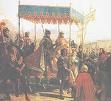



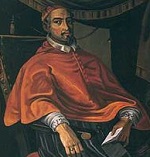



1495 In Jan. Charles VIII of France leads an army of 50K through Pavia, Florence, and Rome into Naples on Feb. 22, and is crowned king of Naples; on Jan. 23 as he is approaching Alfonso II of Naples, spooked by bad dreams he abdicates in favor of his son Ferdinand II (Ferrandino) (1469-96) (until Sept. 7, 1496), then flees to a monastery in Sicily and dies on Dec. 18, leaving his splendid Renaissance Poggio Reale and La Duchesca palaces, which Charles VIII calls "an earthly paradise"; on Mar. 31 fearing for France taking over all of Italy, Maximilian I, Spain, England, Milan, Doge Agostino Barbarigo of Venice and Pope Alexander VI form the Holy League (of Venice) against him, launching the Italian War of 1495 against him (ends 1498), sending an army under Duke Francesco II Gonzaga of Mantua, which forces Charles VIII to beat a hasty retreat from Naples on May 20, arriving in Pisa on June 20; they carry with them the yummy new disease of syphilis, brought by Columbus' men from the New World to Naples via the friendly hookers; responding to the Pisan pleas to expel the Florentines, Charles VIII loses his chance to escape from Italy, and the Holy League tries to block his retreat path to France, resulting in the July 6 Battle of Fornovo (forn for fornication?) 18 mi. SW of Parma (the start of gunpowder warfare?), after which the League of Venice temporarily expels the French from the Italian peninsula back to the Alps; the Albanian mercenaries loot the French baggage instead of keeping the French cut-off, allowing them to escape, and this defeat causes the Holy League to break up; Ferdinand II reconquers Naples, captures the French fleet at Rapallo, and causes the French army to capitulate at Novara on Sept. 24 (sieged since July 1). On Feb. 17 after experiencing the first recorded hurricane near Hispaniola and gathering 1.6K male and female slaves on Haiti, Christopher Columbus' expedition embarks with the healthiest 550, leaving the rest for sale; about 200 Indians die on the voyage and are thrown overboard. In the spring 22-y.-o. well-educated James IV of Scotland assumes personal rule, going on to rule for 18 years with only three parliaments. In Mar. the Imperial Diet of Worms is called by HRE Maximilian I, and proclaims Perpetual Peace, and attempts to modernize the medieval German empire with constitutional reform, setting up an imperial chamber (Reichskammergericht) at Frankfurt (later Speier, then Wetzlar in 1689) along with a court of appeal, also imposing a penny gen. tax. On Apr. 10 Ferdinand II and Isabella I of Spain issue a proclamation permitting all Spaniards to travel to the New World and settle Espaniola. On Oct. 25 king (since Aug. 28, 1481) Joao (John) II the Perfect Prince (b. 1455) dies, and since his son Infante Alfonso (1475-91) died in a horse-riding acceident near the Tagus River on July 13, 1491, his fortunate first cousin the duke of Beja becomes Emanuel (Manuel) I (the Great) (the Fortunate) (1469-1521), king #14 of Portugal (until Dec. 13, 1521), reigning over the country's golden era, when it becomes the first country in world history to acquire a global overseas empire. In Dec. Charles VIII of France disbands his army in Lyons, and his lusty men go on to spread syphilis all over Europe (the French call it the Neapolitan disease, and the Spaniards call it the French disease); Ludovico Sforza brokers a peace between France and the allies, becoming the beginning of the idea of balance of power in European politics; meanwhile Italian physician Jacopo Berengario da Carpi (1460-1530) makes a killing treating syphilis with mercury at hundreds of crowns per patient, paid in advance, getting him an invitation to work for the pope, which he declines in favor of an appointment to Bologna U., where he goes on to pub. "Anatoma Carpi" in 1535, becoming the #1 anatomist in Europe until Andreas Vesalius. Perkin Warbeck unsuccessfully tries to land at Deal, Kent, then moves to the court of James IV of Scotland, who receives him at Stirling and supports his claim to the English throne, and plans an invasion of England in order to force Henry VII to marry his daughter Margaret Tudor to him and make him a star. Otranto is occupied by the French. The Cape Verde Islands become part of the Portuguese empire. Neuchatel N of Lake Neuchatel joins the Swiss Confederation. Ottoman bad boy Jem (brother of Bayezid II) dies in Naples. Sir William Stanley, Henry VII's Lord Chamberlain is executed for complicity in the Warbeck conspiracy. Askia Mohammed goes on pilgrimage from Timbuktu to Mecca carrying 300K pieces of gold. The English Parliament frames a new statute of treasons and an act against vagabonds and beggars. A dry dock is built in Portsmouth, England. King's College in Aberdeen, Scotland (later the U. of Aberdeen) is founded under a papal bull by Bishop William Ephinstone; a royal charter is granted in 1498. Albrecht Durer opens a studio at Nuremberg, and travels to Italy. Desiderius Erasmus goes to the U. of Paris, enrolling in the College de Montaigu under ascetic Dutch priest Jan Standonck (1454-1504), where he becomes a humanist despite the horrible treatment Standonck gives the students, incl. starving them, forcing them to drink diseased water, and frequent whippings to destroy their pride; Standonck learned his stuff from ascetic St. Francis of Paola. U. of Santiago de Compostela in Santiago de Compostela, Galicia, Spain is founded, and approved in 1504 by Pope Julius II; it takes until 1526 for Pope Clement VII to issue a bull for it screation; in 1555 Dominican Cardinal Juan Alvarez de Toledo (1488-1557) begins separating it from purely religious instruction, adding scientific studies. French-Flemish composer Josquin des Pres (1450-1521) is appointed organist and choirmaster at Cambrai Cathedral, going on to become the Beethoven of his day. Nonfiction: Bartholomeus Angelicus, De Proprietatibus Rerum; trans. John de Travisa. Art: Jacopo de Barbari, Portrait of Luca Pacioli. Carlo Crivelli (1430-95), St. Francis with the Blood of Christ. Andrea Mantegna (1431-1506), Holy Family with St. Elizabeth and the Young St. John. Il Perugino (1445-1523), The Entombment. If the savior made her worthy, who indeed are you to reject her? San greal or Sang real? Leonardo da Vinci (1452-1519) begins painting the 15 ft. x 29 ft. chalice-challenged The Last Supper (Il Cenacolo) (L'Ultima Cena) (finished 1498) on the back wall of the refectory of Santa Maria delle Grazie in Milan at the request of Duke Ludovico Sforza and Duchess Beatrice d'Este, employing his unusual disastrous technique of tempera over pitch, gesso, and mastic, which begins to flake in 1517, and which Grigorio Vasari calls "ruined" in 1556; the opposite wall is covered by a Crucifixion fresco, done this year by Giovanni Donato da Montorfano (1450-1503), to which Leonardo adds figures of the Sforza family in tempera; the painting is based on John 13:21: "When Jesus had thus said, he was troubled in spirit, and testified, and said, Verily, verily, I say unto you, that one of you shall betray me"; the tablecloth has a knot in it; there is no cup visible, only dishes, but Christ's left hand points to some bread, and the right hand points to more bread, which is being grabbed by guess who Judas the Betrayer; his swooning "beloved disciple" on his right hand (Mary Magdalene or St. John?) looks like a red-haired woman with perky duckies, her clothes (red robe, blue tunic) are a mirror-image of his (blue robe, red tunic), and her outline fits neatly on his left in a lovey-dovey position, joined hip to hip; woman-hating St. Peter is next to Mary, and in his right hand he holds a mean knife, as if he's threatening her, although it is actually pointing at Bartholomew (leftmost, followed by James the Lesser and Andrew); Judas is 2nd after Mary, the only one to rest his elbow on the table, holding his money bag and getting ready to eat bread to fulfill Christ's prediction; too bad, in 1st cent. Judea people sat on the floor on pillows; too bad that everybody back then painted John as effeminate, incl. him in other paintings; still, the way he makes her a little too effeminate and mates him to Jesus might mean he's trying to fool the uninitiated and send a message, so true believers keep your faith; on Christ's left are TLW, er, Doubting Thomas, James the Greater and Philip, followed by Matthew, Jude Thaddeus and Simon the Zealot, giving four groups of three; in 1652 the monks allow a doorway to be cut in the wall through the center base (later bricked up), destroying the low middle portion; in 1768 a curtain is hung over it for protection, which traps moisture, rotting it faster, plus scratching it as it is being pulled back; after a bunch of damage is done to the painting by restorers, on Aug. 15, 1943 the refectory is bombed, but the painting is protected by sandbags; a modern restoration in 1978-99 by Pinin Brambilla Barcilon restores its original appearance, although some critics claim it was botched; Napoleon's soldiers later use the painting for target practice, throwing rocks and boots at the apostles and defacing Christ's head; luckily many copies are made, esp. the engraving by Raphael Sanzio Morghen (1758-1833) in 1800; a superimposed reverse image allegedly reveals a person holding a baby, while Mary Magdalene vanishes and a Knight Templar in red robe appears on both sides of the table. Peter Vischer the Elder, Gothic Memorial to Archbishop Ernest of Saxony in Magdeburg Cathedral; complete with statues of the Twelve Apostles. Plays: Peter Dorland van Diest, Elckerlijk; basis of the 1510 English morality play "Everyman". Novels: Matteo Mario Boiardo, Orlando Innamorato (posth.); romantic epic. Births: Italian poet-statesman Luigi Alamanni (Alemanni) (d. 1556) on Mar. 6 in Florence; ends up in the French court of Francis I after he plots against Giulio de' Medici of Florence and is forced to flee to Venice, then France after his enemy becomes the pope; inventor of the Italian epigram. English duchess and French queen consort (1514-5) Mary Tudor (d. 1533) on Mar. 18 in Sheen Palace, London; youngest child of Henry VII (1457-1509) and Elizabeth of York (1466-1503); brother of Henry VIII (1491-1547); wife of Louis XII of France, and Charles Brandon, 1st duke of Suffolk (1484-1545); not to be confused with Queen Mary I (1516-58). German humanist astronomer-cartographer Petrus Apianus (Peter Apian) (d. 1552) on Apr. 16 in Leisnig, Saxony; born Peter Bienewitz (Bennewitz), he translates "Biene" (bee) to Latin; educated at the U. of Leipzig. German Bavarian co-duke (1516-45) Louis X (d. 1545) on Sept. 18 in Grunwald; son of Albert IV and Kunigunde of Austria (daughter of HRE Frederick III); brother of William IV (1493-1550). German Lutheran theologian Erhard Schnepf (Schnepff) (d. 1558) on Nov. 1 in Heilbronn. English Protestant historian-playwright (bishop of Ossory, Ireland in 1552-) John Bale (d. 1563) on Nov. 21 in Cove (near Dunwich), Suffolk; educated at Jesus College, Cambridge U. English Lutheran martyr Robert Barnes (d. 1540) in King's Lynn, Norfolk; educated at Cambridge U., and U. of Leuven. Italian painter Polidoro (Caldara) da Caravaggio (d. 1543) (b. 1499?) in Caravaggio; pupil of Maturino of Florence (1490-1528) and Raphael (1483-1520); no relation to Michelangelo Merisi da Caravaggio (1565-1609). German Anabaptist leader Melchior Hoffman (Hofmann) "the Furrier" (d. 1543) in Schwabisch Hall. Spanish conquistador and witch-finder Pascual de Andagoya (d. 1548). Italian Franciscan priest Matteo Bassi (da Bascio) (Matteo Sarafini) (d. 1552) in Molino di Bascio, Montefeltro, Urbino. Spanish viceroy of New Spain #1 (1535-50) and viceroy #3 of Peru (1551-2) Antonio de Mendoza y Pacheco, 4th Count of Tendilla (d. 1552) in Alclala la Real (modern-day Jaen); son of Inigo Lopez de Mendoza y Quinones, 2nd count of Tendilla and Francisco Pacheco. English merchant-financier Sir John Gresham (d. 1556) in Holt, Norfolk; uncle of Sir Thomas Gresham (1519-79); of an old Norman family tracing back to Ralph de Braunche, a knight of William I the Conqueror; founder of Gresham's School. Ottoman scholar (greatest of Suleyman's reign) Ahmed Tashkopruluzade (d. 1561). Spanish architect Diego de Siloe (Siloé) (d. 1563) in Burgos. English cleric and composer William Whytbroke (d. 1568). Deaths: English breed mare Cecily Neville, duchess of York (b. 1415) on May 13 in Berkhamsted Castle, Hertfordshire. Italian painter Cosimo Tura (b. 1430). Italian king Alfonso II of Naples (b. 1448) on Dec. 18 in Messina, Sicily. Portuguese king (1481-95) John II the Perfect (b. 1455) on Oct. 25 in Alvor, Algarve. Ottoman pretender sultan Cem (b. 1459) in Capua, Naples, Italy.





1496 This is a big Millennium Fever (MF) year, with several prophets predicting the End of the World. On Mar. 10 Columbus departs La Isabela for Spain, reaching Portugal on June 8, ending his second voyage in 2 years 8.5 mo.; Romano Pane, a monk who went on the voyage becomes the first to describe the tobacco plant; Columbus writes to Ferdinand and Isabella: "We can send from here, in the name of the Holy Trinity, all the slaves and brazilwood which could be sold. If the information I have is correct, we can sell 4,000 slaves, who will be worth at least 20 millions, and 4,000 hundredweight of brazilwood, which will be worth just as much." In Mar. Henry VII of England commissions John Cabot (1450-98) and his sons Sebastian Cabot (1476-1557) et al. to search for a northerly route to China (Asia), and they leave in the summer on one ship, but run out of supplies and encounter bad weather, turning back. On Apr. 16 duke of Savoy (since 1490) Charles II (b. 1489) dies in Moncalieri after falling by/from his bed, and his granduncle Philip II the Landless (1438-97) unexpectedly inherits the duchy of Savoy (until 1497); too bad, several females in the line of succession dispute his titles to Cyprus and Jerusalem, and he counters by having his 16-y.-o. eldest son Philibert II marry Charles II's 9-y.-o. sister Yolande Louise (1487-99) and just Donald Trump, er, take what he wants - so much for that "landless" rap? On June 3 French Roman Catholic priest Jean Langlois, who had travelled in Europe and picked up humanist ideas interrupts a Mass in Notre Dame Cathedral in Paris, pushing the priest aside and scattering the sacred hosts from his chalice before stomping them and declaring that the idea of Christ's real presence in them is a superstition; after Dutch monk Jan Standonck tries to get him to repent, he is defrocked, the hand that offended the sacred chalice lopped off, and ridden backwards on a donkey to the pig market, where he is burned, allgedly repenting to Standonck in the flames, causing the latter to stay on a strict Lenten fast for life; meanwhile on Oct. 26 the Chapter of Notre Dame Cathedral orders all priests in the diocese to give up any women they are living with, which meets with violent opposition. On June 23 Pope Alexander VI rents out several bldgs. in Rome to be used as bordellos; they continue to operate for almost a cent., just in time to spread syphilis to holy pilgrims? On June 25 Michelangelo (1475-1564) arrives for the first time in Rome, and begins sculpting Bacchus (finished 1497); he stays in Rome until 1501. On Sept. 1 Venetian politician Marin Sanudo (Marino Sanuto) the Younger (1466-1536) begins a Diary for 1496-1535, which is pub. in 1879-1903 - talk about those miserable blues, oh yeah? In Sept. James IV of Scotland and Perkin Warbeck lead a Scottish force into Northumbria, destroying tower houses in the Tweed and Till River Valleys, pissing-off Henry VII and causing him to plan an invasion of Scotland for next year. The first Tomkat marriage wasn't in Hollyweird? On Oct. 20 Hapsburg heir Philip I the Handsome, Duke of Burgundy (1478-1506), son of HRE Maximilian I of Austria and Duchess Mary of Burgundy marries Princess Joanna (Juana) the Mad (1479-1555), heiress of Castile, the daughter of Ferdinand II/V and Isabella I in Lier N of Brussels, allying the Hapsburgs and Trastamaras against the French; they go on to have six children (two boys, four girls), all of whom grow up to be emperors or queens. In Oct. Ferdinand II of Naples dies after regaining control, and his uncle Frederick III of Altamura (-1501) becomes king of Naples (until 1501). On Dec. 25 a decree is signed as part of the betrothal of Manuel I and the Infanta Isabella of Spain, giving the Jews in Portugal until Oct. of next year to convert into "New Christians" or leave - Christian Portugal, love it or leave it? The Education Act requires Scottish nobles to send their sons to learn Latin and law - to be just like William Wallace? The English set up the line of The Pale around Dublin, Ireland, demarcating English rule - the limits of the dog pound? The city of Ciudad Trujillo, capital of La Española (modern-day Santo Domingo, capital of the Dominican Repub., pop. 955K/2.9M) is founded, with Columbus' son Diego as its first viceroy, becoming the oldest continuous European settlement in the Americas, the first seat of Spanish govt. in the West Indies, and the oldest cathedral and univ. in the New World. The zloty (pr. zwahty) (Polish "golden"), equal to 30 groszy (groschen) becomes the official currency of Poland. James IV of Scotland dumps mistress Marion Boyd for Margaret Drummond (1475-1502) (until 1497) of Drummond Castle, who bears him daughter Margaret, which James brings to Stirling after she dies. Jesus College at Cambridge U. is founded by Rochester bishop John Alcock (1430-1500) on the ruins of the 12th cent. Benedictine nunnery of St. Mary and St. Radegund; the logo is the cockerel; alumni incl. Canterbury archbishop Thomas Cranmer - he's bragging? John Colet begins lecturing at Oxford U. Nonfiction: Isaac Abravanel (1437-1508), Sources of Salvation. Franchino Gafori (1451-1522), Practica Musica; treatise on musical composition. Luca di Pacioli (1445-1517), De Viribus Quantatis (1496-1508); first printed reference to card tricks, along with instructions on how to juggle, eat fire, and make coins dance; first printed mention of Leonardo da Vinci's left-handedness; founds modern magic and math puzzlemaking?; lost until modern times. Regiomantanus finishes Peurbach's Epitome in Almagestum, based on Greek sources, and pub. it in Venice; it is later used by Nicolaus Copernicus as a source of data. The English word "mop" is first documented (spelled mappe). Art: Gentile Bellini (1427-1507), Procession of the True Cross in Piazza San Marco. Albrecht Durer (1471-1528), Apocalypse of St. John (series of 16 woodcuts) (1496-8). Il Perugino (1445-1523), The Madonna in Glory with the Child and Saints. Plays: Juan del Encina (1469-1529), Cancionero (Easter play). Johann Reuchlin (1455-1522), Sergius (Latin comedy). Births: French queen consort (1514-15) (Roman Catholic) Mary Rose Tudor, Duchess of Suffolk (d. 1533) on Mar. 18 in Richmond Palace; 5th child and 3rd daughter of Henry VII and Elizabeth of York; younger sister of Henry VIII, who names his daughter and warship after her; 3rd wife of Louis XII, and Charles Brandon, 1st duke of Suffolk. Swedish king (1523-60) ("Father of Modern Sweden") Gustav (Gustavus) I Eriksson Vasa (d. 1560) on May 12 in Rydboholm Castle, Uppland; son of Erik Johansson Vasa and Cecilia Mansdotter; founder of the House of Vasa. English lord chancellor Sir Richard Rich, 1st Baron Rich (d. 1567) in July in St. Lawrence Jewry, London; educated at Cambridge U.; knighted in 1533; created baron in 1548. French duke of Guise #1 (1528-50) Claude of Lorraine (d. 1550) on Oct. 20 in Chateau de Conde-sur-Moselle; 2nd son of Duke Rene II of Lorraine (1473-1508). French Renaissance poet Clement Marot (Clément) (d. 1544) on Nov. 23 in Cahors, Quercy; son of Jean Marot (Maris) (Marets) (des Mares) (1463-1523), of Norman descent, poet laureate to Queen Anne of Brittany. Flemish composer Lupus (Wulfard) Hellinck (d. 1541) (b. 1493/4?) in Axel, Terneuzen, Zeeland (Saint-Donatien, Bruges?). Spanish conquistador Hernando de Soto (d. 1542) (b. 1495?) in Jerez de los Caballeros, Badajoz, Extremadua, Castile. Irish lord deputy of Ireland (1540-) Sir Anthony St. Leger (Sellenger) (d. 1559); eldest son of Ralph II St. Leger; grandson of Ralph I St. Leger (-1470); educated at Cambridge U.; knighted in 1539. Dutch (Flemish) painter Lancelot Blondeel (d. 1561). Dutch Mennonite founder (ex-Catholic priest) Menno Simons (Simonszoon) (d. 1561) in Witmarsum, Friesland. Swiss patriot-historian-monk ("the Prisoner of Chillon") Francois Bonivard (Bonnivard) (d. 1570) in Seyssel; born into an old Savoy family; educated in Turin. German composer Johann Walther (d. 1570). English poet Sir Richard Maitland (d. 1586) of Lethington. Deaths: German-born French printer Johann Heynlin (b. 1425) on Mar. 12 in St. Margarethenthal, Germany; dies in a Carthusian monastery. Austrian archduke (1439-90) Sigismund of Austria (d. 1427) on Mar. 4. Portuguese queen Isabella (b. 1428) on Aug. 15. Italian painter Piero del Pollaiolo (b. 1443) in Rome. Italian psychic Milo Giacomo Rambaldi (b. 1444) :). Italian painter Ercole de'Roberti (b. 1451). Italian Naples king (1495-6) Ferdinand II of Naples (b. 1469) on Sept. 7.




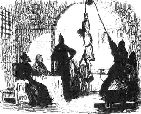

1497 Early in the year after a severe famine in Florence, Girolamo Savonarola casts Ovid's Ars Amatoria, along with the works of Dante and several chess sets and other "vanities" into the "bonfire of the vanities", and gets excommunicated for attempting to depose Pope Alexander VI; in May his enemies break into the Santa Maria del Fiore, smear the pulpit with excrement, place the rancid carcass of a donkey on it, and drive nails under the book rest. On Apr. 3 after being rejected by the French dauphin, Margaret of Austria (1480-1530), marries the Infanta of Spain, John (Don Juan) of the Asturias (1478-97), son of Ferdinand II and Isabella I, who dies on Oct. 4; meanwhile Manuel I of Portugal marries Spanish Infanta Isabella (d. 1498). In Apr. the 11K-man army of the duchy of Courland invades the neighboring province of Memel, and after a large Polish force arrives from Polotsk and Welikia to help them, they chase the Teutonic Knights N, after which the Polish army captures Dorpat and gains control of Livonia, then heads S to meet an invasion of Hanseatic forces. On May 2 John Cabot leaves on his first voyage in the Matthew of Bristol, owned by English merchant (of Welsh descent) Richard Amerike (Ameryk) (1445-1503), trying a course far to the N of Columbus', and on June 24 (St. John the Baptist's Day) discovers Cape Breton Island and Newfoundland, becoming the first white Euros to rediscover the mainland of North Am., returning on Aug. 6 with news of fish not gold, so people are unimpressed; since Amerike backed earlier expeditions of Bristol sailors to Newfoundland as far back as 1479, and his family coat of arms is stars and stripes, some later argue that America was named for him not Amerigo Vespucci; the Chinese have a gold mining operaton on Cape Breton Island, that soon eats shoots and leaves? Perkin Warbeck arrives in Cork, Ireland from Scotland, fails to gain support, then lands in Cornwall during the Cornish Rebellion of 1497, led by atty. Thomas Flamank (son of a royal tax collector) and Michael Joseph (Myghal Josep), AKA An Gof (Gael. "blacksmith"), which starts after Parliament attempts to impose a tax for the proposed invasion of Scotland, causing 15K to march unopposed across the English countryside on London; on June 17 they meet the English army at Deptford Bridge at Blackheath, and are defeated, with 2K KIA and the leaders executed by July 22, becoming the last major revolt against Norman rule in Britain since their brazen 1066 takeover - way to go, Liberace? On July 8 Portuguese explorer Vasco da Gama (1460-1524) sails from Lisbon in four ships for a voyage around Africa to India, and rounds the Cape of Good Hope on Nov. 22; his voyage is long enough for scurvy to be discovered. In July James IV unsuccessfully sieges Norham Castle in England; on Sept. 30 after abandoning plans for an invasion, England signs a 7-year truce with Scotland, Henry VII still refusing to lower his daughter to marriage with a mere Scottish king (until 1502). In Sept. after the Poles under John I agree with Moldavian prince Stephen III (his tributary) to stage an expedition to the Black Sea to kick Ottoman butt and restore Moldavia's access to the sea, and Stephen gets incorrect reports that John is planning to replace him with his brother Sigismund I the Old, causing him to pillage Galicia, John I leads 80K freaked-out troops and sieges the Moldavian capital of Suczawa on Sept. 26-Oct. 26, only to run out of supplies after finding out about Stephen's scorched earth tactics; on Oct. 26 after Stephen allows them safe passage back provided they take the same route back (which would have kept them starving), they are ambushed during their retreat on a narrow road in the thickly wooded forest at the Battle of the Cosmin (Kozmin) Forest in N Moldavia (30 mi. N of Suceava), taking them apart for three days, and intercepting a Polish force sent to relieve them at Lentesti on Oct. 29; after Lithuanian grand duke Alexander Jagiello intervenes, the decimated Poles are allowed to escape - who's next on my hit list? On Oct. 14 Perkin Warbeck is captured by royalist troops at Beaulieu Abbey in Hampshire, and imprisoned in the Tower - I'm baack? On Nov. 7 Philip II (b. 1438) dies, and his eldest son Philibert II (the Handsome) (the Good) (1480-1504) becomes duke of Savoy (until Sept. 10, 1504); he and his wife Holande Louise take the titles of king-queen of Cyprus, Jerusalem, and Armenia. On Dec. 25 (Christmas day) Vasco da Gama sights and names the South African country of Natal (Birthday). King Hans of Denmark-Norway invades Sweden to claim his crown from regent Sten Sture, whose peasant army is defeated in two battles; in Nov. Hans is crowned king of Sweden; he then goofs up leads a German mercenary army along with Duke Frederik to subjugate the peasant Repub. of the Ditmarshes (Dithmarschen), but heavy rains and mud cause the heavy cavalry to slip and slide, and the two kings barely escape, humiliating them and causing Sweden to want its independence. The Castilians invade N Africa (until 1510), and take the port of Melilla in NE Morocco - this one's for 711? King John II of Denmark defeats the Swedish army at Brunkeberg, enters Stockholm, and revives the Scandinavian Union. Cesare Borgia's brother Giovanni, duke of Benevento and Gandia is assassinated, and guess who is suspected? Vietnamese emperor (since 1460) Le Thanh-Tong (b. 1442) dies, and a succession of civil and regional wars follows, with eight kings placed on the throne from 1505-27, and six of them assassinated. James IV of Scotland appoints his brother Duke James Stewart of Ross (1476-1504) as archbishop of St. Andrews (until 1504), causing whispers. The town of Sarzanello, Italy constructs the first Ravelin (originally called a Demi-Lune), a triangular fortification standing outside the castle, giving rise to the star fort system of fortifications. About this time the Aztecs under Ahuizotl have their last battle with the Zapotecs in SE Mexico, known for wearing cotton armor. The canton of Grisons (Graubunden) SE of the original nucleus of Uri-Schwyz-Unterwalden joins the Swiss Confederation. Lucrezia Borgia's marriage to Giovanni Sforza is annulled by her daddy the pope on grounds of impotence. A papal bull by Pope Alexander VI launches the Portuguese Inquisition of Marranos (Sp. "swine"), secret Jews forced to feign conversion to Roman Catholicism - to test them make them eat swine flesh? Conradus Celtis introduces humanism to Vienna. Nonfiction: Isaac Abravanel (1437-1508), Salvation of His Anointed. John Alcock (1430-1500), The Hill of Perfection. Art: Filippino Lippi (1457-1504), Meeting of Joachim and Anne at the Golden Gate. Luis Ramirez Lucena (1465-1530), Repeticion de Amores y Arte de Axedres. Michelangelo (1475-1564), The Manchester Madonna (Virgin and Child with St. John and Angels). Births: German Protestant humanist reformer Philip (Philipp) Melanchthon (Schwartzerdt (d. 1560) on Feb. 16 in Bretten (near Karlsruhe); educated at the U. of Heidelberg. Spanish gov. of Chile #1 (1540-7, 1549-53) (one of the least rapacious?) Pedro de Valdivia (d. 1553) on Apr. 17 in Villanueva de la Serena, Vegas Altas, Badajoz, Estremadura; serves under HRE Charles V during the Italian wars of 1527-30, then becomes an officer under Francisco Pizarro in 1535, going on to conquer Chile. Italian comic poet Francesco Berni (d. 1535) (b. 1498?) in Lamporecchio (near Florence), Tuscany; inventor of burlesque lit.? German portraitist-printmaker Hans Holbein the Younger (d. 1543) in Augsburg, Bavaria; son of Hans Holbein the Elder (1465-1524); known for his portraits of Henry VIII of England. English lawyer-historian Edward Halle (Hall) (d. 1547) in Shropshire; educated at Eton School, and King's College, Cambridge U. Italian Roman Catholic Counter-Reformation humanist scholar Agostino Steuco (Eugubinus Steuchus) (d. 1548) in Gubbio, Umbria; coiner of the term "perennial philosophy" (philosophia perennis). Swiss Protestant leader Hans Franz Nageli (Nägeli) (d. 1579) in Aigle. French physician (coiner of the term "physiology") Jean Francois Fernel (d. 1558) in Montdidier. English dramatist John Heywood (d. 1580) in Coventry; educated at Broadgates Hall, Oxford U.; grandfather of John Donne. Deaths: English organist-composer Henry Abyngdon (b. 1418). Italian "Dance of Salome" painter Benozzo Gozzoli (b. 1420). Italian Florentine painter Francesco Botticini (b. 1446) on July 22. Italian duchess of Milan (1494-7) Beatrice d'Este (b. 1475) on Jan. 2 (dies in childbirth). Italian almost-duchess (of Ferrara) Anna Sforza (b. 1476) Dec. 2 (dies in childbirth); her death ends the short bond between the Sforza and d'Este families. Spanish infante Don Juan of the Asturias (b. 1478) on Oct. 4.





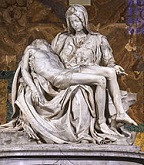
1498 Call or click Progressive.com today? On Apr. 7/8 king (since 1483) Charles VIII of France (b. 1470) dies childless after hitting his head on the lintel of a door at the Chateau d'Amboise, and the 2nd cousin of his father, Duke Louis of Orleans, son of poet Charles of Valois, Duke of Orleans (1394-1465) (who fathered him at age 71 after spending 25 years in captivity in the Tower of London following the 1415 Battle of Agincourt) becomes Louis XII (1462-1515), Valois king #8 of France (only king of the Valois-Orleans branch) (whose portrait bears a striking resemblance to Hollywood actor John Malkovich (1953-)?), his rule proving to be so mild that he gains the title "Father of the People" (Le Pere du Peuple); after being crowned at Rheims Cathedral on Dec. 17, Louis XII divorces his wife Jeanne de France (Charles VIII's sister) and next Jan. 8 marries childless 21-y.-o. Anne of Brittany, widow of Charles VIII, pissing off local know-it-all monk Jan Standonck, who preaches against divorce except in cases of adultery, which gets him two years of exile; Anne wears white at her wedding, creating a fad; the dukedom of Orleans merges into the crown (until 1626); Louis XII adds Milan to his Italian claims, and sets his sights on Duke Ludovico the Moor. Just what the Indians need? On May 20 Portuguese explorer Vasco da Gama (1460-1524) becomes the first European to sail around Africa to reach India as he arrives in Kappakadavu near Calicut (Calcutta) on the Malabar coast, finding that Arab merchants already live there; on Aug. 29 he departs for Portugal, sailing against the monsoon winds, taking 132 days to reach the Arab-run coastal town of Malindi (pop. 6K) next Jan. 7 (vs. 23 days the other way to India), during which time half of his crew dies, and the rest get scurvy; Game Vasco meets with the sheik of Malindi to sign a trade agreement, and hires a guide for his voyage to India, erecting a coral pillar, which survives to modern times; next year the Portuguese establish a trading post in Malinda, followed in 1509 by a custom house, which is abandoned in 1512, although Malindi remains the center of Portuguese activity in E Africa until 1593; the discovery of the sea route to India (bypassing the Muslim-infested Mediterranean) opens the Age of Global Imperialism, with round-trip distances longer than round-the-globe voyages along the equator. On May 23 after a plot to blow him to pieces in his cathedral fails, followed by an armed assault and siege on his Convent of San Marco supported by the govt., hated Dominican friar and demagogue Girolamo Savonarola (b. 1452) is hung along with two other friars, then burned at the stake in the Piazza Signoria in front of the Palazzo Vecchio in Florence before a capacity crowd, and his ashes scattered in the river to prevent the collection of holy relics. Pale Euros in search of the perfect tan? On May 30 Christopher Columbus leaves Sanlucar, Spain on his Third Voyage with six ships, arriving on July 31 on Trinidad (Sp. "Trinity") (named after three mountains on the SE side) (the Arawaks and Caribs call it "land of the hummingbird") off the coast of Venezuela, then discovering the sister island of Tobago (Indian name Tobaco, from the tobacco grown there) 20 mi. to the NE (later believed to be the site of Daniel Defoe's "Robinson Crusoe"), then the island of Grenada (not colonized); he then visits the coast of South Am., sighting the mouth of the Orinoco River, believing it to be flowing out of the Garden of Eden; he arrives at Hispaniola on Aug. 19. In May after receiving honors from Henry VII along with new letters patent in Feb., Venice-born London explorer John Cabot begins his Second Voyage with five ships, travelling hundreds of miles down the ragged E coast of North Am. incl. Labrador and Newfoundland, after which one ship returns damaged by a storm; he either wrecks near Grates Cove and dies, or returns in spring 1500 and dies 4 mo. later. In Aug. Cesare Borgia resigns as cardinal; in Nov. he is sent to France as papal legate to convey to Louis XII an annulment of his marriage to his consort Jeanne, causing Louis XII to reward him with the duchy of Valentinois, 20K livres a year, and a 100-man bodyguard; meanwhile Lucrezia Borgia, declared officially to still be a virgin marries 17-y.-o. Don Alfonso, Prince of Aragon (1481-1500), AKA the Duke of Bisceglie, illegitimate son of Alfonso II of Naples, as part of a plot by Cesare Borgia to marry Carlotta, daughter of King Frederick III of Naples; Cesare Borgia becomes gov. of Spoleto. Perkin Warbeck makes a public confession of treason, and is locked up in the Tower of London. Duke Albert of Saxony is rewarded for his services in the Netherlands by HRE Maximilian I by being created hereditary gov. (potestat) of Friesland, but after subduing most of it and returning to Saxony, only to be faced with another rebellion, he dies in 1500, leaving his subjects with the debt for it all. The Magdeburg Law (Rights) are passed, regulating the degree of internal autonomy within cities and villages granted by a local ruler, becoming the most important set of medieval Germanic city laws; it spurs the development of thousands and cities and villages incl. Biecz, Frysztak, Sandomierz, Krakow, Kurow, Minsk, Polotsk, Poznan, Ropczyce, Lodz, Wroclaw, Szczecin, Zlotoryja, Vilnius, Trakai, Kaunas, Hrodna, Kiev, Lviv, Czernowitz (modern-day Chernivtsi in Ukraine), Brody, Lutsk, Volodymyr-Volynskyi, Sanok, Sniatyn, Nizhyn, as well as Bardejov, Humenne (Humenné) and Krupina in modern-day Slovakia. Well-laid James IV of Scotland dumps mistress Margaret Drummond for Janet Kennedy (1479-1545), former mistress of Archibald, 5th earl of Angus, who is installed in Darnaway Castle, bearing illegitimate son James Stewart, 1st Earl of Moray (1500-44). The U. of Palermo in Italy is founded. Desiderius Erasmus visits England for the first time, and begins teaching at Oxford, meeting up with humanist churchman John Colet, who turns him on to Greek, which he spends three years mastering. The first German pawnshop opens in Nuremberg. Donato Bramante leaves Milan after 28 years (since 1472), and spends the rest of his life working in Rome (until 1514). Architecture: St. Mary the Virgin in Oxford (begun 1300) is completed. Ft. Mehrangarh in Jodhpur, India is built by Rao Jodha (1416-89). Inventions: Gun barrel rifling is invented in Germany. Nonfiction: Anon., Novo Receptario (Florence); the first pharmacopeia? Isaac Abravanel (1437-1508), Proclaiming Salvation (Feb. 26). Boethius (480-524), Opera; his ancient Roman treatise on music is pub. in Venice by Johannes and Gregorius de Gregoriis (1488-9). Philippe de Comines (1445-1509), Memoires; causes him to become known as the "French Macchiavelli". Polydore Vergil (1470-1557), Liber Proverbiorum (Proverbiorum Libellus) (Adagia) (Apr.) (Venice); first pub. collection of Latin proverbs; dedicated to Duke Guido Ubaldo of Urbino. Art: Michelangelo (1475-1564), Pieta (Pietà) (sculpture) (Rome); larger-than-life-sized; depicts the lifeless Christ in the lap of the mourning Virgin Mary; sculpts himself as Nicodemus; after hearing a group of sightseers erroneously attribute his work to another sculptor, he chisels his name into it, but regrets it later and never signs another work - I'll never be a cicerone? Plays: The Aldine Press of Venice pub. the comedies of Aristophanes. Johann Reuchlin (1455-1522), Henno (Latin comedy). Poetry: Hinrek van Alkmar, Reinke de Vos (Dutch animal epic). Births: French cardinal (1518-) Jean de Lorraine (d. 1550) on Apr. 9 in Bar-le-Duc, Lorraine; 3rd son of Rene II, duke of Lorraine (1451-1508); and Philipa of Guelders (1467-1547); uncle of Nicholas of Lorraine; friend of Francis I; richest prelate in France. Portuguese infante Miguel da Paz, Prince of Portugal and Asturias (d. 1500) on Aug. 23 in Zaragoza; son of Manuel I )1469-1521) and 1st wife Isabella of Aragon, princess of Asturias (1470-98). Spanish Augustian friar-explorer Andres (Andrés) de Urdaneta y Cerain (d. 1568) on Nov. 30 in Ordizia, Gipuzkoa, Castile. German Luthern theologian Andreas Osiander (Hosemann) (d. 1552) on Dec. 19 in Ansbach, Bavaria. Italian humanist physician Giovanni Battista Monte (Johannes Baptista Montanus) (d. 1551) in Verona; friend of Andreas Vesalius; teacher of John Caius and Valentinus Lublinus. Italian Renaissance painter Il Moretto (Alessandro Bonvicino) (d. 1554) in Brescia. Italian High Renaissance ms. illuminator and painter Giorgio Giulio Clovio (Juraj Julije Klovic) (d. 1578) in Grizane, Croatia; immigrates to Italy at age 18; friend of El Greco and Pieter Bruegel the Elder. Deaths: Spanish Grand Inquisitor Torquemada (b. 1420) on Sept. 16 in Avila - eyes wide shut, running to my brain? Italian artist Antonio del Pollaiuolo (d. 1429) on Feb. 4 in Rome; dies rich after finishing the mausoleum of Pope Innocent VII. Bavarian painter-woodcarver Michael Pacher (b. 1435). Italian architect-sculptor Benedetto da Majano (b. 1442) on May 24 in Florence. Italian religious reformer Girolamo Savonarola (b. 1452) on May 23 in Rome (executed). German plus-minus mathematician Johann Widmann (b. 1462). French king (1483-98) Charles VIII the Affable (b. 1470) on Apr. 6/7 in Amboise. Italian explorer (in England's service) John Cabot (b. 1474) near Grates Cove. Spanish Infanta Isabella (b. 1498) (dies during childbirth). Spanish finance minister (baptized Jew) Luis de Santangel (b. ?) in Avila; born in Valencia.
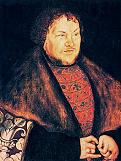



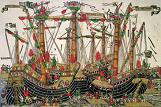




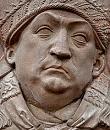
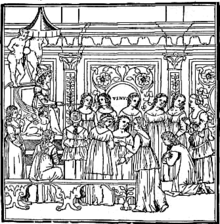

1499 A mathematician in Tubingen, Germany foretells a coming planetary alignment in 1524, claiming it will bring a worldwide flood. French marshal Gian-Jacopo Trivulzio utters the immortal soundbyte: "To wage war, three things are necessary: money, money, and yet more money." On Jan. 8 Louis XII marries Charles VIII's still-tight (22) widow Anne of Brittany, insuring the union of Brittany with France to keep it whole; he then asserts French claims in Italy and, backed by Venice, invades and captures Milan (Sept. 10) and Genoa, and expels Duke Ludovico Sforza from Milan, causing him to flee to the Tirol (Tyrol), and starting the Second Italian War (Louis XII's Italian War) (War Over Naples) (ends 1504); ex-cardinal Cesare Borgia marries the king of Navarre's sister and accompanies Louis XII to Italy, unsuccessfully attempting the conquest of Romagna for the Holy See; patronless Leonardo da Vinci makes friends with the French, and leaves Milan for Mantua, where he makes a Drawing of Isabella d'Este, wife of the duke of Mantua, then visits Venice briefly before returning to Florence by next spring; a colossal Bronze Statue of Ludovico Sforza's Late Father Astride a Horse is discontinued, and the 79 tons of bronze used for cannon; a full-scale clay model of the riderless horse is broken to pieces by French soldiers using it for archery practice. On Jan. 9 Brandenburg elector (since 1486) John II Cicero (b. 1455) dies, and his eldest son Joachim I Nestor (1484-1535) becomes prince-elector #5 of Brandenburg (until July 11, 1535), becoming known for high-pressure sales tactics for indulgences, causing Roman Catholic priest Martin Luther to launch his first attack against his brother Archbishop Albert first. In Jan. the fortress of Memel falls to the army of Courland, which is down to 8.6K men, during which time a 5K-man Teutonic Order sieges Riga, and after Courland raises the siege, they sign a peace in Dec. In Jan. their relations going downhill since 1492, Doge Agostino Barbarino and Ottoman sultan Bayezid II begin the Second (Fourth) Ottoman-Venetian War (ends 1503), causing Venetian merchants in Constantinople to be arrested while Bosnian troops invade Dalmatia and siege Zara, and Ottoman adm. Kemal Reis (1451-1511) (paternal uncle of Piri Reis) sets sail from Constantinople itching to try out the new expanded fleet; on Aug. 12-25 the naval Battle of Zonchio (Sapienza) (First Battle of Lepanto) (first naval battle in history where cannons are used on ships) in the Ionian Sea is a V for the 67-galley Ottoman force over the 47-galley Venetian force under Antonio Grimani (1434-1523), the tide turning when two Venetian carracks attempt to board the command ship of Burak Reis, and he sets all three afire, hurting Venetian morale, after which the Italian naval base of Lepanto surrenders; after the sultan gives 10 of the captured galleys to him, Kemal Reis stations his fleet on Cefalonia Island between Oct.-Dec., with the goal of taking the remaining bases of Modone and Corone; in Dec. the Venetians recapture Lepanto, and Reis sails right back and rerecaptures it. On Apr. 6 after being sent by Manuel I of Portugal, Italian explorer Amerigo Vespucci (1454-1512) allegedly reaches the South Am. mainland, then returns to Cadiz on Oct. 15. On May 16 Alonzo de Hojeda (Alonso de Ojeda) (1468-1515) (cmdr.), Amerigo Vespucci (1451-1512) (pilot), and Juan de la Cosa (the Biscayan) (1450-1510) (navigator and cartographer, co-discoverer of America with Columbus and owner of the Santa Maria) leave Cadiz, Spain, and sail to the mouth of the Amazon River, discovering Curacao (Curaçao) (40 mi. N of Venezuela) and Bonaire on July 29, and Lake Maracaibo on Aug. 9, naming Venezuela (Sp. "little Venice") for Venice because the inhabitants live in houses built over the water; they also explore the Arawak island of Aruba 18 mi. off the coast of Venezuela; Ojeda becomes the Neil Armstrong of (first white Euro to set foot on) the South Am. continent; after discovering the Amazon River, they sail to Cape de la Vela, then reach Espanola with slaves and pearls, only to be accused of trespassing on Columbus' turf; Vespucci observes Venezuelan natives chewing coca leaves, writing: "They kept this herb in their mouths to stave off thirst." In July John Macdonald of Islay, lord of the Isles in Scotland (since 1476) is hanged along with his sons by crown agent Archibald Campbell, 2nd Earl of Argyll (-1513) for failure to pay royal rents, causing a revolt led by Donald (Domhnall) Dubh (-1545), which causes Alexander Gordon, 3rd Earl of Huntly (1463-1524) to replace Archibald as royal lt. of the Highlands to simmer him down. On Sept. 22 after HRE Maximilian I attempts to abrogate Swiss govt. rights, causing the Swabian War between the Swabian League and the Swiss Confederation in Jan. in N and E Switzerland, which is won by the Swiss, the Treaty (Peace) of Basel is signed, establishing Swiss independence. In Sept. after two of his ships precede him in July-Aug., Vasco da Gama arrives in Lisbon, and is welcomed as a hero and awarded the title "Admiral of the Indian Seas" along with Dom (lord) by Manuel I, the latter title also being awarded to his siblings and their descendants; meanwhile Venice is shocked by news of a new sea route to India threatening its commercial supremacy, causing it to eventually begin building an inland empire (Padua, Verona, Cremona et al.) - I still got gama? In Oct. after sailing with Christopher Columbus on his 2nd Voyage and promising to give the Spanish crown one-fourth of his net profits, Spanish explorer Rodrigo de Bastidas (1460-1527) leaves Cadiz for the New World, going on to map the N coast of South Am., discover Panama, and found the city of Santa Marta - we can laugh even while having problems, amen? On Nov. 23 Perkin Warbeck (b. 1474) is executed for continuing to plot against Henry VII after capture and planning an escape from the Tower. In Dec. Columbus veteran Vicente Yanez Pinzon sails from Spain with four caravels for the New World. In Dec. after failing to convince them by reason, Spanish Franciscan inquisitor-gen. Cardinal Francisco Jimenez de Cisneros (1436-1517) (who reformed the Franciscan order in Spain, making them give up their concubines, causing 400 monks and friars to flee with them to Africa and convert to Islam, making him only more determined) begins forced mass conversions and baptisms of Mudejars (Moors remaining in Spain) in Granada, fomenting the First Rebellion of the Alpujarras (ends Apr. 1501) (2nd in 1568-70). Spanish soldier Francisco de Bobadilla (-1502) is appointed to replace Christopher Columbus as viceroy of the West Indies (which they still call the Indies). 12-y.-o. Yolande Louise of Savoy (b. 1487) dies childless, and her first cousin Princess Charlotte of Naples (1479-1506) (only child of Federigo IV of Naples and Anna of Savoy, eldest daughter of Duke Amadeus IX of Savoy and Yolande of Valis, daughter of Charles VII of France) claims Cyprus and Jerusalem, but Philibert II the Handsome of Savoy tells her to stuff it, and plots to marry his handsome self into the Hapsburg family. The Jews are expelled from Nuremberg. 12-y.-o. pre-teen messiah Ismail emerges from exile in Lanjan in Iran, and travels to the regional center of Ardabil in NW Iran to assemble an army of 7K badass Shiites from E Anatolia, Syria and Iraq, which become known as Qizilbash (Kizilbash) ("Red Heads") for their distinct red headwear with 12 points to indicate adherence to the Twelve Imans, then begins a campaign against his daddy's killers the bad White Sheep based in Tabriz. Gold mines are discovered in Santo Domingo, giving the Spaniards a reason not to slaughter the remaining natives like pigs, because they can be worked like mangy dogs to death instead? A bear is put on trial for ravishing some German villages; his defense atty. has the proceedings delayed for over a week arguing that it has a right to be tried by its peers, a jury of bears - bears have more rights than black people? The U. of Oxford begins issuing degrees in music. After Pope Alexander VI issues a papal bull on Apr. 13, Spanish Cardinal Francisco Jimenez (Ximenes) de Cisneros (1436-1517) founds the U. of Alcala (Alcalá) de Henares in Alcala de Henares, Spain on the Henares River E of Madrid as Completense U. (named after the 1st cent. B.C.E. town of Complutum), becoming the first city designed solely as the seat of a univ., where he and his scholars Hernan Nunez de Toledo y Guzman (Hernán Núñez de Toledo y Guzmán) (1475-1553), Diego Lopez de Zuniga et al. begin a big Bible trans. project in 1502, finishing the New Testament in 1514 and the Old Testament in 1517, after which bureaucratic machinery takes until 1520 for Pope Leo X to sanction it, and more foulups hold it up until 1522; Miguel de Cervantes is born there in 1547; the univ. moves to Madrid in 1836, then moves back in the 1970s. Hungary begins producing antimony (which, like water, expands as it cools, making it useful for making sharp-outlined castings) for export. The first political cartoons appear, about the French-Italian war. Ming the Clam is born, becoming the world's oldest living creature by 2006, when it is fished from an Icelandic seabed and killed by scientists trying to determine its age. Gatchina (Khotchino) 28 mi. of modern-day St. Petersburg is first mentioned as belonging to Novgorod the Great. Giggleswick School in Giggleswick (near Settle), North Yorkshire England is founded by Rev. James Carr. The famous beer hall U Fleku is founded in Prague, Czech. Architecture: Bath Abbey in England (begun 1405) is completed. Fiction: Francesco Colonna (1433-1527), The Dream of Poliphilus (Hypnerotomachia Poliphili) (Gk. "hypnos" + "eros" + "mache" = sleep + love + fight)(Poliphilo's Strife of Love in a Dream) (incunable) (Venice); a romance which describes a mythical world filled with fountains where Poliphilo pursues his love Polia, finally getting a kiss by the Fountain of Venus, only to wake up from his dream, causing grand fountains to become a rage in Italy in the 16th-17th cents. Willibald Pirckheimer (1470-1530), Bellum Helveticum. Johannes Trithemius (1462-1516), Steganographia (3 vols.); pub. in Frankfurt in 1606; too bad, its coverstory of magic and spirits causes it to be placed on the Roman Catholic Prohibited Index until 1900. Polydore Vergil (1470-1557), De Inventoribus Rerum (7 vols.) (Paris); internat. bestseller, making him a star; the origin of all things, incl. the gods, the world, marriage, and religion; dedicated to Ludovicus Odaxius of Urbino; vols. 3-7 are added to shut the Christian community up with origins of Christian institutions; vol. #8 is added in 1521; criticizes indulgences and scholasticism. Art: Albrecht Durer (1471-1528), Portrait of Oswald Krell. Giorgione (1477-1510), Portrait of a Young Man. Il Perugino (1445-1523), Audience Hall of the Cambio in Perugia. Luca Signorelli (1445-1523), Frescoes at Orvieto Cathedral (1499-1504). Veit Stoss (1438-1533), Last Supper; Christ on the Mount of Olives; Taking of Christ (stone reliefs in the Sebalduskirche in Nuremberg). Plays: Henry Medwall (1462-1522), Fulgens and Lucrece: the first purely secular English play. Novels: Fernando de Rojas (1475-1538), Celestina, or the Tragicomedy of Calisto and Melibea (verse novel); how noble lovers Caliso and Melibea carry on amid the night life of Spain with the help of the bawd Celestina, and all come to disaster; #2 Spanish novel of the 16th-17th cent. after Don Quixote. Births: Spanish mystic priest-preacher (Roman Catholic) ("the Apostle of Andalusia") (St.) John of (Juan de) Avila (Ávila) (d. 1569) on Jan. 6 in Almodovar del Campo, Ciudad Real; of Jewish converso descent; educated at the U. of Salamanca, and U. of Alcala de Henares; feast day: May 10. German freethinker-humanist writer Sebastian Franck (Franck von Word) (d. 1543) on Jan. 20 in Donauworth, Bavaria. German celeb ("die Lutherin") Katharina von Bora (d. 1552) near Pegau, Saxony; wife (1525-46) of Martin Luther (1483-1546). French queen and breed mare Claude, Duchess of Brittany (d. 1524) on Oct. 24 in Romorantin; eldest daughter of Louis XII and Anne of Brittany; 1st wife of Francis I; mother of Henry II. French noble mistress (of Henri II) Diane de Poitiers (d. 1566) on Sept. 3 in Saint-Vallier, Drome. Spanish (Portuguese?) explorer Juan Rodriguez Cabrillo (d. 1543) in Palma del Rio, Cordoba. English "Defence of Good Women" scholar-diplomat Sir Thomas Elyot (d. 1546); son of Sir Richard Elyot and 1st wife Alice de la Mare. Swiss humanist scholar Thomas Platter the Elder (d. 1582) on Feb. 10 in Grachen, Valais; father of Felix Platter (1536-1614) and Thomas Platter the Younger (1574-1628). German Protestant theologian-reformer Johann (Johannes) Brenz (d. 1570) on June 24 in Weil der Stadt (20 mi. W of Stuttgart); educated at the U. of Heidelbrg. Franciscan friar ("Father of Modern Ethnography") Bernardino de Sahagun (Sahagún) (Ribeira) (d. 1590) in Sahagun, Leon, Spain; educated at the U. of Salamanca. Deaths: Italian Neoplatonic philosopher Marsilio Ficino (b. 1433) on Oct. 1 in Careggi, Repub. of Florence; leaves Theologia Platonica de Immortalitate Animae (pub. 1525). German prince-elector #4 of Brandenburg (1486-99) John II Cicero (b. 1455) on Jan. 9 in Arneburg Castle.